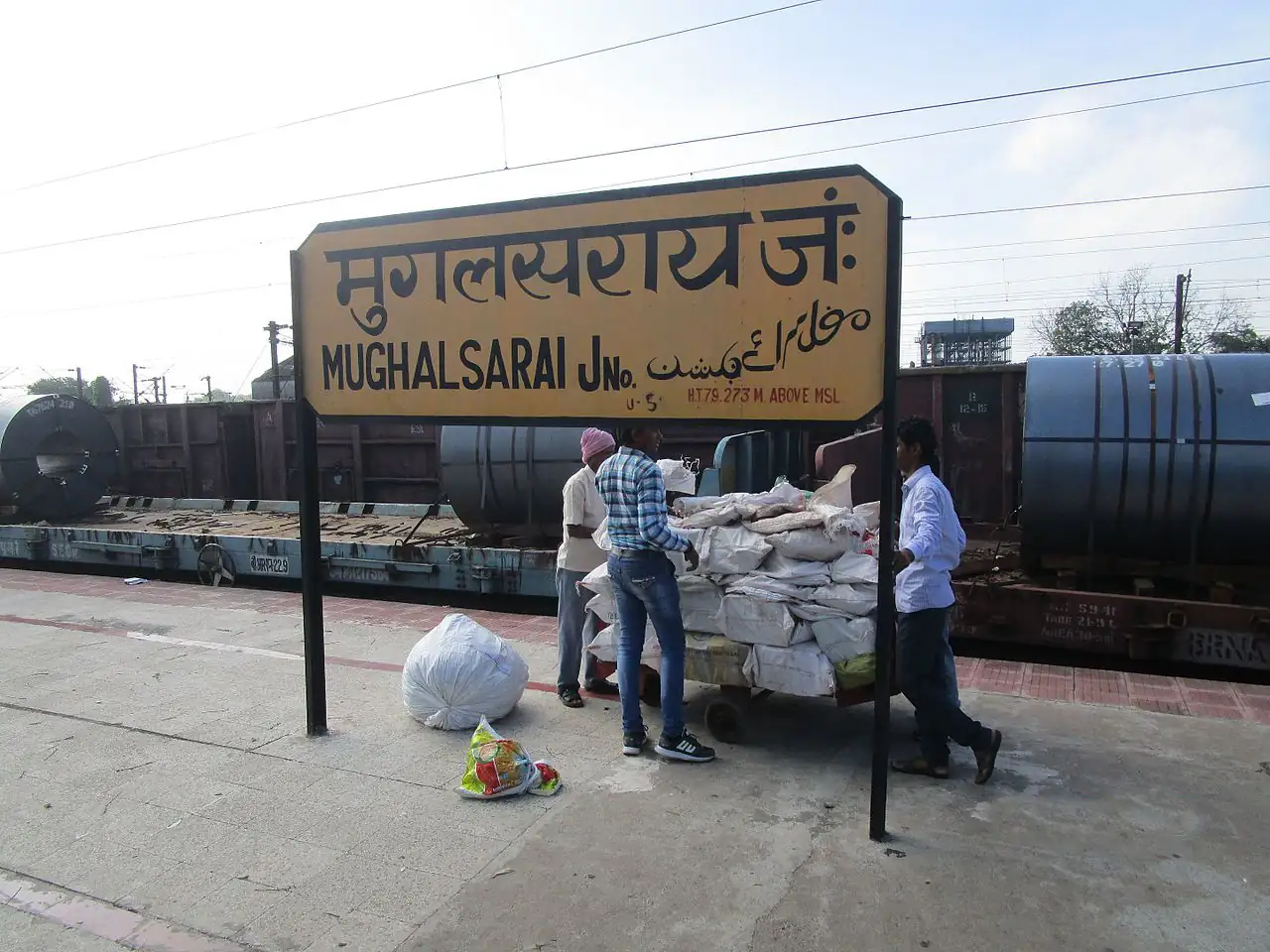“Where History Meets the Rails: Unraveling the Legacy of Mughalsarai”
🔴 Introduction: The Crossroads of Heritage and Modernity
Mughalsarai, officially renamed Pandit Deen Dayal Upadhyaya Nagar in 2018, is more than just a bustling railway junction in Uttar Pradesh. Nestled along the banks of the Ganges and bisected by the historic Grand Trunk Road, this city is a tapestry of Mughal legacies, colonial architecture, and vibrant local culture. For centuries, it has served as a critical corridor connecting North India to the eastern states, earning its reputation as a lifeline for traders, pilgrims, and travellers.
In this comprehensive guide, we’ll journey through Mughalsarai’s layered history, explore its architectural gems, and decode its modern-day significance. From granular demographic insights to monsoon travel itineraries, we’ve crafted this article to cater to history buffs, architecture enthusiasts, and curious wanderers alike.
Table of Contents
- 🔴 Introduction: The Crossroads of Heritage and Modernity
- 🟢 Detailed Introduction:
- 🔘 Introduction: Mughalsarai – Where Eras Collide on the Banks of the Ganges
- 🔘 A Name That Echoes Through Centuries
- 🔘 Geography: The River, the Rails, and the Road
- 🔘 Demographics: A Microcosm of India’s Diversity
- Also Read
- 🔘 Economy: Wheels of Progress
- 🔘 Architecture: Colonial Legacies and Sacred Spaces
- 🔘 Notable Faces: From Prime Ministers to Local Heroes
- 🔘 Cultural Tapestry: Festivals, Food, and Folklore
- 🔘 Why Mughalsarai Matters Today
- 🟣 Section Breakdown:
- 🟠 Detailed Section Breakdown:
- ⭕ History Unearthed: From Mughal Caravans to Modern Railways
- ➤ Timeline of Transformation
- ➤ Local Voices:
- ⭕ Architectural Wonders: Colonial Rail Heritage & Sacred Spaces
- ➤ Pandit Deen Dayal Upadhyaya Junction
- ➤ Sacred Sites
- ➤ Architectural Analysis:
- ⭕ Navigating Mughalsarai: Distances from Major Cities
- ⭕ Cultural Mosaic: Demographics, Economy & Local Lifestyles
- ➤ Demographics (2011 Census)
- ➤ Economy:
- ➤ Local Market Gems:
- ⭕ Traveler’s Toolkit: Weather, Itineraries & Food
- ➤ Best Time to Visit
- ➤ 3-Day Itinerary:
- ➤ Must-Try Foods:
- 🔵 Detailed Section-By-Section Breakdown
- Architectural Marvels in and near Mughalsarai, Uttar Pradesh: A Granular Exploration
- I. Taj Mahal (Agra, 25 km from Mughalsarai): The Pinnacle of Mughal Elegance
- II. Agra Fort (Agra, 28 km): Fusion of Military and Palatial Design
- ➨ Notable Sections:
- III. Fatehpur Sikri (35 km): Akbar’s Vision of Cultural Synthesis
- IV. Itimad-ud-Daulah’s Tomb (Agra, 22 km): Proto-Taj Experimentation
- V. Akbar’s Tomb (Sikandra, 30 km): Symbolic Syncretism
- VI. Chunar Fort (25 km Southwest): Geological Integration
- VII. Mughalsarai Junction (DDU Station): Industrial Mughal Legacy
- VIII. Architectural Techniques and Legacy
- IX. Practical Exploration Tips
- Comprehensive Guide to Reaching Mughalsarai (Deen Dayal Upadhyaya Nagar), Uttar Pradesh
- I. Air Connectivity
- Nearest Airport:
- ➨ Lal Bahadur Shastri International Airport (VNS), Varanasi (30 km / 45–60 minutes by Road).
- ➨ Ground Transport from Varanasi Airport:
- II. Rail Networks
- A. From Delhi (724 km)
- B. From Kolkata (Howrah Junction, 555 km)
- C. From Mumbai (CSMT, 1,550 km)
- D. Regional Connectivity
- III. Road Networks
- A. National Highways
- B. Bus Services
- ➨ State Transport (UPSRTC):
- C. Self-Drive/Rental Cars
- IV. Regional Travel Hubs
- A. From Bihar
- B. From Madhya Pradesh
- C. From Uttarakhand
- V. Local Transport in Mughalsarai
- VI. Seasonal and Practical Tips
- ➨ Peak Travel Windows:
- ➨ Budget Hacks:
- ➨ Safety Notes:
- VII. Special Considerations
- VIII. Final Tips: Strategic Routing
- Best Places to Visit in and near Mughalsarai, Uttar Pradesh: A Granular Guide
- I. Historical Landmarks
- 1. Chunar Fort (25 km Southwest)
- 2. Mughalsarai Junction
- II. Natural Escapes
- 1. Chandraprabha Wildlife Sanctuary (65 km West)
- 2. Ramgarh Tal (8 km Northeast)
- III. Spiritual Sites
- 1. Katari Mata Ka Mandir (Central Mughalsarai)
- 2. Gauria Math (3 km from Station)
- IV. Nearby Excursions (Within 15 km)
- 1. Sarnath (14 km North)
- 2. Varanasi Ghats (11–12 km Northwest)
- V. Practical Visiting Strategies
- ➸ Seasonal Timing:
- ➸ Transport:
- ➸ Cultural Etiquette:
- VI. Hidden Gems
- Where to Stay in and near Mughalsarai, Uttar Pradesh, India: A Comprehensive Guide
- Best Places for Refreshments with Authentic Local Food in Mughalsarai, Uttar Pradesh: A Granular Culinary Guide
- I. Railway Junction Eateries: Fast Bites for Transit Passengers
- II. Heritage Hotel Dining: Traditional Flavours in Refined Settings
- III. Street Food Hubs: Chaotic Charm and Iconic Snacks
- A. Katari Mata Mandir Precinct
- B. Ramgarh Tal Lake Area
- IV. Tea Culture: Chai Stalls as Social Epicentres
- V. Vegetarian Havens: Temple Bhojanalayas and Maths
- VI. Meat Lovers’ Corners: Mughal-Inspired Kebabs and Biryanis
- VII. Sweet Sanctuaries: Mithai Shops with Legacy Recipes
- VIII. Practical Tips for Food Exploration
- IX. Final Tips: Savouring History in Every Bite
- Climatic Conditions in Mughalsarai, Uttar Pradesh, India: A Granular Analysis
- I. Annual Temperature Profile
- II. Monsoon Dynamics and Rainfall
- III. Humidity and Muggy Conditions
- IV. Solar Radiation and Daylight Hours
- V. Wind Patterns and Air Quality
- VI. Seasonal Breakdown with Travel Implications
- 1. Pre-Monsoon (March–Mid-June)
- 2. Monsoon (Late June–September)
- 3. Post-Monsoon (October–November)
- 4. Winter (December–February)
- VII. Extreme Weather Events
- VIII. Climate-Responsive Travel Planning
- ➸ Health Precautions:
- IX. Climate Change Trends
- Sociocultural Mosaic of Mughalsarai: Castes, Tribes, and Languages
- I. Demographic and Geographic Context
- II. Scheduled Castes (SCs): Structure and Distribution
- III. Other Backward Classes (OBCs) and Upper Castes
- IV. Scheduled Tribes (STs): Niche Communities
- V. Linguistic Diversity: Official and Vernacular Tongues
- VI. Dialectical Subregions and Literary Heritage
- Literary traditions include:
- VII. Socioeconomic Dynamics and Language
- ➸ Religion-Language Links:
- VIII. Cultural Synthesis and Modern Challenges
- IX. Final Thoughts: A Microcosm of Eastern UP’s Diversity
- Notable Personalities of Mughalsarai (Deen Dayal Upadhyaya Nagar): Legacy and Contributions
- I. Historical Foundations and Cultural Context
- II. Lal Bahadur Shastri (1904–1966): India’s Humble Prime Minister
- III. Political Leaders and Electoral Influence
- A. Deendayal Upadhyaya (1916–1968): Ideological Icon
- B. Contemporary Representatives
- IV. Religious and Cultural Figures
- A. Katari Mata Mandir Guardians
- B. Syncretic Spiritual Voices
- V. Literary and Artistic Connections
- VI. Railway Community Pioneers
- VII. Contemporary Voices
- VIII. Sporting Talent
- IX. The Naming Controversy: Identity Politics
- X. Final Thoughts: A Microcosm of India’s Soul
- Industrial Development and Industries in Mughalsarai (Deen Dayal Upadhyaya Nagar), Uttar Pradesh: A Granular Analysis
- I. Historical Foundations and Economic Evolution
- II. Core Industrial Sectors and Infrastructure
- A. Railway-Logistics Ecosystem
- B. Manufacturing Clusters
- 1. Agro-Processing Units:
- 2. Textile Ancillaries:
- III. Strategic Industrial Initiatives
- A. Uttar Pradesh Industrial Development Authority (UPSIDA) Projects
- B. Connectivity-Led Industrialisation
- IV. Small-Scale Industries (SSIs) and MSMEs
- V. Industrial Challenges and Constraints
- 1. Infrastructure Deficits:
- 2. Bureaucratic Hurdles:
- 3. Labor Market Issues:
- VI. Policy Interventions and Incentives
- VII. Socioeconomic Impact and Employment
- VIII. Future Industrial Trajectory
- 1. Green Energy Integration:
- 2. Industrial Corridor Expansion:
- 3. Skill Development:
- IX. Final Thoughts: Balancing Legacy and Innovation
- ⭕ FAQs: Why Did Mughalsarai Station Lose Its Name?
- ⭕ Conclusion

🟢 Detailed Introduction:
🔘 Introduction: Mughalsarai – Where Eras Collide on the Banks of the Ganges
Nestled along the timeless flow of the Ganges River, Mughalsarai—officially Pandit Deen Dayal Upadhyaya Nagar—is a city where History, Culture and Modernity converge. Renowned as one of India’s busiest railway junctions, this Uttar Pradesh gem is more than a transit hub; it’s a living chronicle of Empires, Trade Routes and Socio-political evolution.
From its Mughal-era caravanserais to its colonial-era railways, Mughalsarai has long been a crossroads for travellers, traders, and dreamers. Let’s embark on a journey through its layered past, vibrant present, and the stories etched into its soil.
🔘 A Name That Echoes Through Centuries
The city’s identity has evolved alongside India’s tumultuous history. Originally known as Mughalchak or Oven Nagar under Mughal rule, it flourished as a rest stop for caravans traveling Sher Shah Suri’s Sadak-e-Azam (Grand Trunk Road). The British renamed it Mughalsarai in 1883 when they established the railway junction, a nod to its Mughal roots.
In 2018, a controversial rebranding honored Pandit Deen Dayal Upadhyaya, a Hindu nationalist thinker, sparking debates about erasing history versus reclaiming indigenous identity. For locals like 72-year-old shopkeeper Abdul Rahim, “The name changed, but our memories of bullock carts and steam engines remain”.
🔘 Geography: The River, the Rails, and the Road
Mughalsarai’s geography has shaped its destiny. Bisected by NH19 (the modern avatar of the Grand Trunk Road) and hugged by the Ganges, the city is a logistical linchpin. To the south lie sprawling railway colonies like Vasant Vihar and European Colony, their British-era bungalows with red-tiled roofs standing in contrast to the chaotic energy of Galla Mandi, the bustling grain market. The northern banks, dotted with villages like Amoghpur and Taranpur, retain an Agrarian Rhythm, where farmers till fields that have fed empires for centuries.
🔘 Demographics: A Microcosm of India’s Diversity
The 2011 Census paints a vivid portrait: a population of 109,650, with 70.2% literacy and a mix of Hindi, Bhojpuri, and Urdu speakers. Nearly 16% belong to Scheduled Castes and Tribes, reflecting Uttar Pradesh’s complex social fabric. Walk through Qassab Mohalla, and you’ll hear the clang of blacksmiths beside Sufi Qawalis from Roza Sharif, a shrine revered across faiths. As schoolteacher Anjali Mishra notes, “Here, Ramadan diyas light up alongside Holi colours—it’s our everyday unity”.
Also Read
Explore Katni, Madhya Pradesh: History, Culture, and Nature
🔘 Economy: Wheels of Progress
The city thrives on its railways. The Pandit Deen Dayal Upadhyaya Junction — India’s fourth-busiest station—employs thousands, while small industries like Chunar’s pottery workshops and textile units fuel the local economy. Yet, agriculture remains a lifeline; the fertile Gangetic plains yield wheat, rice, and pulses, traded in markets that have operated since Mughal times. “My father sold grains here; now I sell mobile accessories”, laughs Rajesh Yadav, whose family stall in Galla Mandi mirrors the city’s transformation.
🔘 Architecture: Colonial Legacies and Sacred Spaces
Mughalsarai’s skyline tells twin tales of colonialism and spirituality. The railway station’s Victorian arches and clock towers stand as monuments to British engineering, while nearby Kailashpuri Colony’s cantonment-style homes whisper of a bygone era.
Contrast this with the minimalist elegance of Dharamshala Temple or the vibrant mosaics of Shri Radha Krishna Mandir, where devotion transcends architectural styles. “The station’s design was meant to awe”, explains historian Dr. Meera Singh. “But our temples and shrines awe in quieter, enduring ways”.
🔘 Notable Faces: From Prime Ministers to Local Heroes
This unassuming city birthed icons. Lal Bahadur Shastri, India’s second Prime Minister, took his first breaths here, his childhood home now a pilgrimage for history buffs. Modern-day leaders like MLA Ramesh Jaiswal continue shaping its political landscape. Yet, unsung heroes abound—like Asha Devi, a retired railway employee who runs a free library for slum children. “Mughalsarai gave me a job; now I give back”, she says, embodying the city’s spirit of resilience.
🔘 Cultural Tapestry: Festivals, Food, and Folklore
Monsoons here are not just about rain but Kajari festivals, where farmers sing folk songs to invoke fertile fields. Winter mornings smell of Chooda Matar (Spicy flattened rice) sizzling in street carts, while summers see families flock to Rehmatullah’s kulfi stall, a 50-year-old institution. The Alampur Road Market offers more than goods—it’s where artisans sell black clay idols, their craft passed down since the Mughal era. “Our hands mould clay, but our stories mould the next generation”, says potter Ramdeen Prajapati.
🔘 Why Mughalsarai Matters Today
Beyond its historical allure, Mughalsarai is a mirror to modern India’s challenges and triumphs. Its railway junction handles 125+ daily trains, connecting metros like Delhi and Kolkata, yet struggles with overcrowding. The 2018 renaming debate echoes nationwide conversations about history and identity.
As urban planner Arvind Khanna observes, “This city is a lab—balancing heritage with progress, diversity with development”. Whether you’re a history enthusiast, a culture vulture, or a curious traveler, Mughalsarai invites you to unpack its layers—one story, one samosa, one train whistle at a time.
🟣 Section Breakdown:
🎯 History Unearthed: From Mughal Caravans to Modern Railways
🎯 Architectural Wonders: Colonial Rail Heritage & Sacred Spaces
🎯 Navigating Mughalsarai: Distances from Major Indian Cities
🎯 Cultural Mosaic: Demographics, Economy & Local Lifestyles
🎯 Traveler’s Toolkit: Best Time to Visit, Weather & Itineraries
🎯 FAQs: Why Did Mughalsarai Station Loose Its Name?

🟠 Detailed Section Breakdown:
⭕ History Unearthed: From Mughal Caravans to Modern Railways
Mughalsarai’s origins trace back to the 16th century, when it emerged as a pitstop for Mughal caravans traversing Sher Shah Suri’s Sadak-e-Azam (Grand Trunk Road). Initially called Mughalchak or Oven Nagar, its strategic location made it a melting pot of traders and travellers.
➤ Timeline of Transformation
⦿ 1883: The British established the Mughalsarai Junction, transforming it into a critical rail hub.
⦿ 2018: Renamed Pandit Deen Dayal Upadhyaya Nagar to honour the Bharatiya Jana Sangh leader, sparking debates on erasing colonial legacies.
➤ Local Voices:
“My grandfather worked here as a stationmaster in the 1950s. The name ‘Mughalsarai’ wasn’t just a label—it was our identity”, shares Ramesh Kumar, a third-generation resident.
⭕ Architectural Wonders: Colonial Rail Heritage & Sacred Spaces
➤ Pandit Deen Dayal Upadhyaya Junction
This 4th busiest railway station in India boasts Victorian-era platforms, arched brick facades, and a clock tower reminiscent of British engineering. Over 125 trains pass daily, including the Rajdhani Express.
➤ Sacred Sites
⦿ Chandra Prabha Wildlife Sanctuary: Located in Chandauli District, in the south eastern part of UP, between Chakia & Naugarh. [ 70km from Varanasi ].
⦿ Kashi Vishwanath Corridor: Just 20 km away in Varanasi, this newly revamped temple complex is a spiritual magnet.
➤ Architectural Analysis:
The railway colonies like European Colony and Diesel Colony feature bungalows with sloping roofs and verandas, blending colonial practicality with Indian aesthetics.
⭕ Navigating Mughalsarai: Distances from Major Cities
| City | Distance (By Rail) | Travel Time |
| Kolkata | 680 km | 15-17 hours |
| Delhi | 780 km | 12-14 hours |
| Mumbai | 1,450 km | 24-26 hours |
Note: Distance and travel time may vary. Please check with google maps or local authorities before travelling.
Pro Tip: Opt for overnight trains like the Mumbai-Howrah Mail for a scenic journey through Uttar Pradesh’s hinterlands.

⭕ Cultural Mosaic: Demographics, Economy & Local Lifestyles
➤ Demographics (2011 Census)
⦿ Population: 1.09 lakhs | Literacy Rate: 81.2%
⦿ Languages: Hindi (85%), Bhojpuri (12%), Urdu (3%)
➤ Economy:
The city thrives on rail logistics, small-scale industries (textiles, pottery), and agriculture (wheat, rice).
➤ Local Market Gems:
⦿ Galla Mandi: A bustling grain market where farmers haggle over monsoon harvests.
⦿ Handicrafts: Look for black clay pottery from nearby Chunar.
⭕ Traveler’s Toolkit: Weather, Itineraries & Food
➤ Best Time to Visit
⦿ October–March: Pleasant weather (15°C – 25°C), ideal for temple-hopping.
⦿ Monsoon Magic (July–September): Lush green landscapes but prepare for delays due to rail congestion.
➤ 3-Day Itinerary:
⦿ Day 1: Explore railway heritage + Roza Sharif.
⦿ Day 2: Day trip to Varanasi’s ghats.
⦿ Day 3: Local markets + Chunar Fort (40 km away).
➤ Must-Try Foods:
⦿ Malaiyo: A frothy milk dessert from Varanasi.
⦿Chooda Matar: Flattened rice with spicy peas (Street snack).
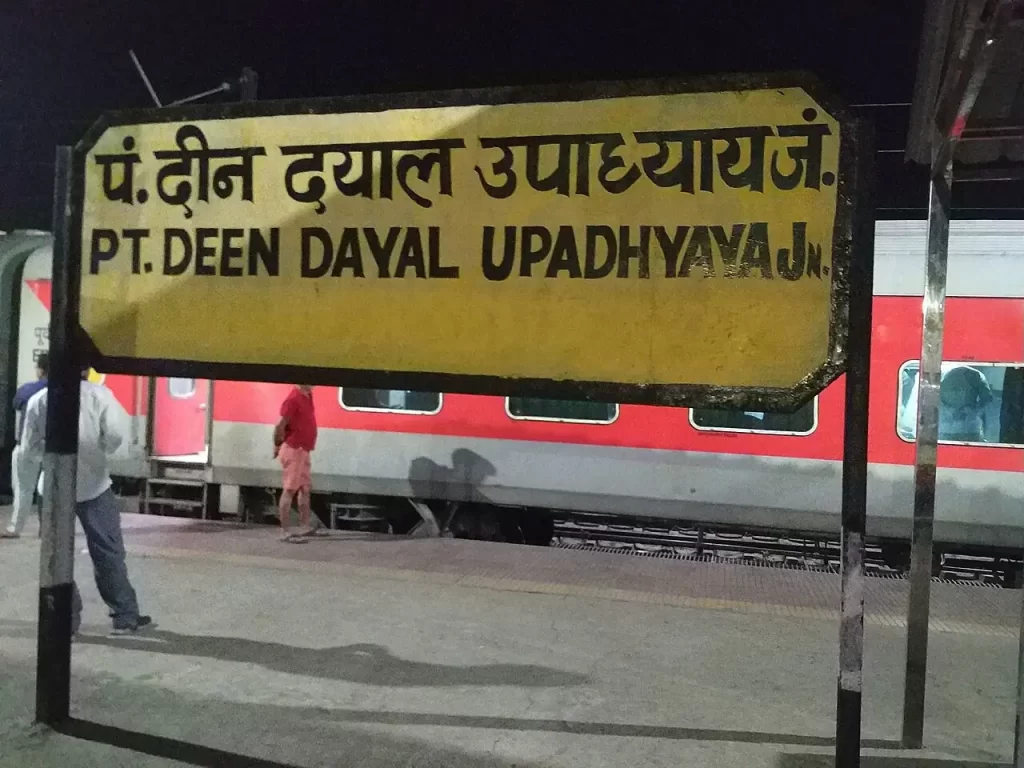
🔵 Detailed Section-By-Section Breakdown
Architectural Marvels in and near Mughalsarai, Uttar Pradesh: A Granular Exploration
Mughalsarai (officially Deen Dayal Upadhyaya Nagar) serves as a strategic gateway to eastern Uttar Pradesh’s rich architectural heritage, particularly the Mughal-era Masterpieces that blend Persian, Indian, and Islamic design philosophies. Though Mughalsarai itself is primarily a transit hub, its proximity (within 25–65 km) to globally renowned monuments offers unparalleled access to structures showcasing Innovative Engineering, Symbolic Ornamentation, and Cultural Syncretism. Below is a detailed analysis of key architectural marvels, with granular insights into materials, design innovations, and historical context.
I. Taj Mahal (Agra, 25 km from Mughalsarai): The Pinnacle of Mughal Elegance
Commissioned by Shah Jahan in 1632 as a mausoleum for Mumtaz Mahal, the Taj Mahal exemplifies the zenith of Mughal architectural refinement:
➸ Structural Symmetry: The complex follows a strict Bilateral Axis aligned with the Yamuna River. The main mausoleum is flanked by identical red sandstone mosques and guest pavilions, creating perfect visual harmony.
➸ Material Innovation: Built from Makrana Marble quarried 400 km away, its surface features Pietra Dura (Parchin Kari) inlay with 43 semi-precious stones, including lapis lazuli (Afghanistan), turquoise (Tibet), and carnelian (Arabia). The dome’s white marble shifts hue from dawn (pink) to dusk (Gold) due to reflective properties.
➸ Engineering Precision: The central dome (35m height) employs a Double-shell design — an outer dome for grandeur and an inner dome for proportional balance. Minarets tilt slightly outward (2.5°) to prevent collapse onto the tomb during earthquakes.
👉 Visitor Details: Open 6 AM – 7 PM (closed Fridays); Night viewing during Full Moon. Entry: ₹1,100 (foreigners); ₹50 (Indians).
II. Agra Fort (Agra, 28 km): Fusion of Military and Palatial Design
Akbar’s 1565–1573 red sandstone fortress demonstrates Mughal adaptability:
➨ Hybrid Construction: The fort’s 2.5 km perimeter walls (21m high) integrate Hindu trabeate systems (Post-and-lintel) with Islamic arches. Over 4,000 sandstone blocks were interlocked without mortar.
➨ Notable Sections:
➸ Jahangiri Mahal: Features Hindu-inspired Chhatris (Domed Pavilions) and Jharokhas (Balconies) with lotus motifs.
➸ Khas Mahal: Showcases Persian-inspired Muqarnas (Honeycomb vaulting) and water-cooled marble floors.
➸ Musamman Burj: Shah Jahan’s octagonal prison tower offers a direct sightline to the Taj Mahal, his wife’s Tomb.
👉 Visitor Details: Open 6 AM – 6 PM; Entry: ₹35 (Indians), ₹550 (Foreigners).
III. Fatehpur Sikri (35 km): Akbar’s Vision of Cultural Synthesis
This short-lived capital (1569–1585) merges Hindu, Jain, and Islamic styles:
➸ Buland Darwaza: The 54m-high victory gate, faced with red sandstone and marble, is the world’s tallest gateway. Inscriptions from the Quran frame its Central Iwan (Arch).
➸ Panch Mahal: A five-story pavilion with 176 columns, each carved uniquely. The structure’s open design facilitated cross-ventilation, while tiered floors segregated royal women.
➸ Diwan-i-Khas: Features a central “Throne Pillar” where Akbar debated scholars. The pillar’s Gujarati design includes serpentine brackets supporting a circular platform.
👉 Visitor Details: Open 6 AM – 7:30 PM; Entry: ₹40 (Indians), ₹510 (Foreigners).
IV. Itimad-ud-Daulah’s Tomb (Agra, 22 km): Proto-Taj Experimentation
Nicknamed the “Baby Taj”, this 1628 mausoleum pioneered techniques later perfected in the Taj Mahal:
➸ Material Transition: First Mughal structure built Entirely in Marble, abandoning red sandstone. Its Pietra Dura depicts Persian wine vessels and European-style floral patterns.
➸ Jali Innovation: Pierced marble screens (Jalis) filter light into the burial chamber, casting star-shaped patterns. The geometric designs avoid human forms, adhering to Islamic Aniconism.
V. Akbar’s Tomb (Sikandra, 30 km): Symbolic Syncretism
Completed by Jahangir in 1613, this tomb reflects Akbar’s pluralist ideology:
➸ Architectural Hybridity: The five-story pyramid combines a Hindu-style terraced base with Islamic Minarets and a Christian crucifix floor plan.
➸ Ornamental Details: Stucco Paintings depict mythical Hindu creatures (e.g., Makara Sea Monsters), while Quranic verses adorn the main gate. The absence of a dome defies typical Mughal funerary conventions.
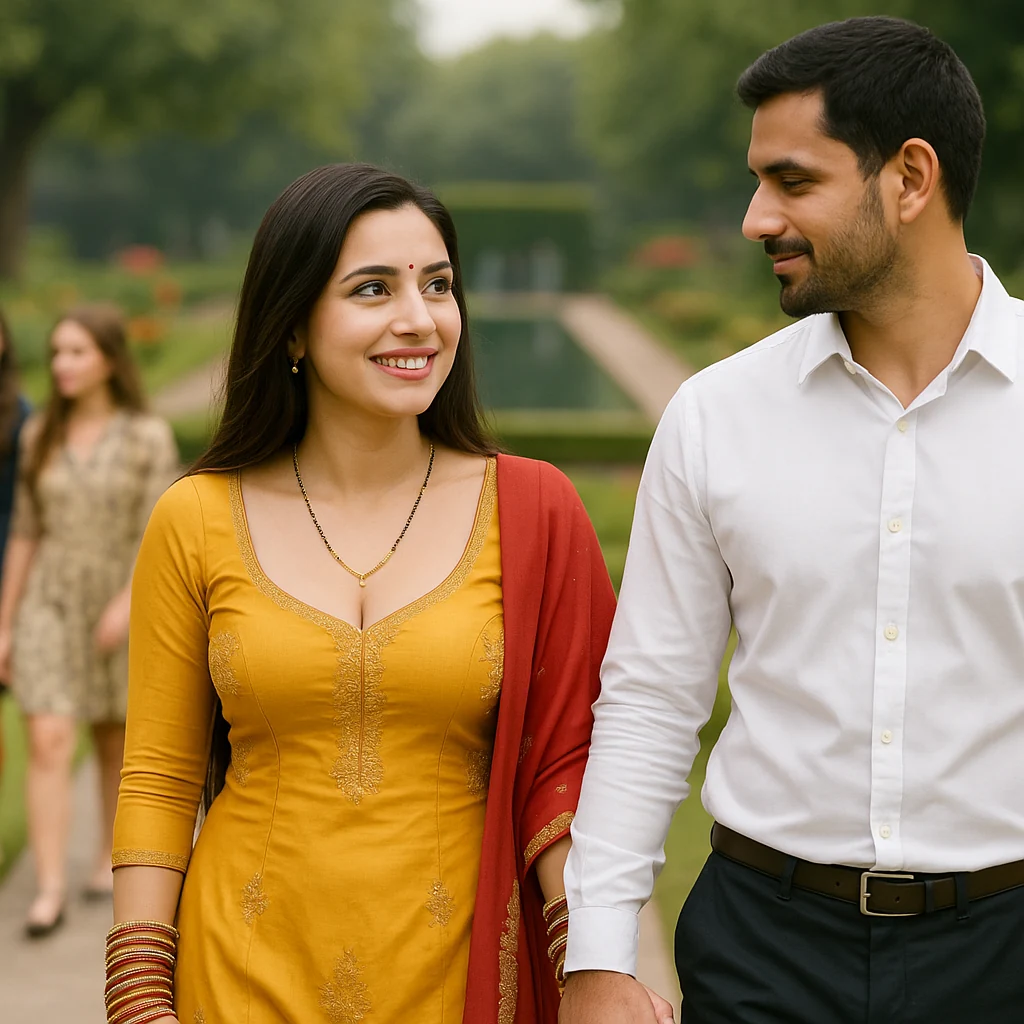
VI. Chunar Fort (25 km Southwest): Geological Integration
This pre-Mughal fort (rebuilt by Babur in 1525) exemplifies Adaptive Reuse:
➸ Rock-Cut Engineering: Carved into a Quartzite Cliff overlooking the Ganges, its ramparts incorporate natural rock formations. The Babar Mosque within uses salvaged Hindu temple pillars.
➸ Strategic Design: Underground tunnels connect barracks to riverfront docks, enabling covert troop movements. The British later added Dungeons with Iron Shackle Rings during the 1857 uprising.
VII. Mughalsarai Junction (DDU Station): Industrial Mughal Legacy
Though modernised, this railway hub retains traces of colonial-era Mughal revivalism:
➸ Indo-Saracenic Features: The main terminal (1907) includes Cusped Arches and Red Sandstone Cladding inspired by Fatehpur Sikri. Platform 1 displays a preserved steam locomotive beside a Chhatri-style canopy.
➸ Operational Grandeur: Asia’s largest Marshalling Yard (12.5 km long) handles 1,500 freight wagons daily. Its lattice girder bridges mirror Shah Jahan’s Bridge Designs.
VIII. Architectural Techniques and Legacy
➸ Garden Integration: Sites like Mehtab Bagh deploy the Chahar Bagh (Quadrilateral Garden) design, with subterranean aqueducts feeding fountains. The Anguri Bagh at Agra Fort grew grapes for royal wine.
➸ Craftsmanship: Pietra Dura artisans used Reverse Inlay — carving marble recesses first, then embedding stones—to achieve seamless floral mosaics in the Taj Mahal.
➸ Regional Adaptation: Unlike Persian monuments, Mughal structures here feature Deep Eaves (Chhajjas) and Overhanging Balconies (Jharokhas) to combat monsoon rains and summer heat.
IX. Practical Exploration Tips
➸ Route Optimisation: From Mughalsarai, hire a cab (₹1,500/day) for a circuit: Chunar Fort → Varanasi (Bharat Kala Bhavan Mughal artefacts) → Agra cluster (Taj, Fort, Sikandra).
➸ Seasonal Timing: Visit October–March (18°C – 25°C). Avoid summer (45°C+) as marble surfaces radiate heat.
➸ Guided Insights: At Fatehpur Sikri, local guides (₹200/hour) decode Akbar’s religious symbolism in the Diwan-i-Khas Pillar.
👉 Final Thoughts: Mughalsarai as a Portal to Imperial Grandeur
Though lacking monumental Mughal structures itself, Mughalsarai’s Strategic Location unlocks Eastern Uttar Pradesh’s architectural treasury — from the transcendental Taj Mahal to the syncretic experiments at Fatehpur Sikri. Each site reveals the Empire’s Technical Ingenuity and Cultural Diplomacy, where Hindu stone-carving traditions fused with Persian geometry and Islamic calligraphy. As you traverse this corridor, the legacy of emperors—Babur’s pragmatism, Akbar’s pluralism, Shah Jahan’s opulence—resonates in stone, offering a masterclass in empire-building through Architecture.

Comprehensive Guide to Reaching Mughalsarai (Deen Dayal Upadhyaya Nagar), Uttar Pradesh
Mughalsarai (officially Pandit Deen Dayal Upadhyaya Nagar) is a critical transportation nexus in eastern Uttar Pradesh, strategically positioned on the Grand Trunk Road (NH-19) and home to one of Asia’s Busiest Railway Junctions. Renamed in 2018 to honor the Bharatiya Jana Sangh leader, this city serves as a gateway to Varanasi (25 km northwest) and connects North India with the eastern states. Below is a granular analysis of travel options from major Indian Regions, Covering Air, Rail and Road networks.
I. Air Connectivity
Nearest Airport:
➨ Lal Bahadur Shastri International Airport (VNS), Varanasi (30 km / 45–60 minutes by Road).
➸ Domestic Flights: Direct connections from Delhi (4–6 daily, 1h 30m, ₹3,200 – ₹8,000), Mumbai (3–4 daily, 2h 10m, ₹4,500 – ₹9,000), and Kolkata (2–3 daily, 1h 45m, ₹3,800 – ₹7,500). Airlines include SpiceJet, Air India, and IndiGo.
➸ International Flights: Limited routes to Bangkok, Colombo, and Dubai (via Air India/SpiceJet).
➨ Ground Transport from Varanasi Airport:
➸ Pre-paid taxis: ₹600 – ₹800 to Mughalsarai (fixed rate; 24/7 availability).
➸ App-based cabs (Ola/Uber): ₹500 – ₹700.
➸ Auto-rickshaws: ₹300 – ₹400 (negotiable; less suitable for luggage).
II. Rail Networks
Pandit Deen Dayal Upadhyaya Junction (DDU) is India’s Fourth-busiest Station, handling 125+ daily passenger trains and 1,500+ freight wagons. Key routes include:
A. From Delhi (724 km)
➸ Rajdhani Express: Nightly; 8h 30m; AC 2-tier (₹1,400), AC 3-tier (₹950).
➸ Vande Bharat Express: Daily; 7h 45m; Chair Car (₹1,100), Executive (₹2,100).
➸ Sleeper Trains: 10–12h; General (₹415), Sleeper (₹550) .
➸ Frequency: 20+ Daily Trains; Peak-season Bookings require 45-day Advance Reservations via IRCTC.
B. From Kolkata (Howrah Junction, 555 km)
➸ Howrah–Delhi Rajdhani: Halts at DDU; 7h; AC 2-tier (₹1,900).
➸ Poorva Express: 8h 15m; Sleeper (₹350), AC 3-tier (₹900).
C. From Mumbai (CSMT, 1,550 km)
➸ Mumbai Howrah Mail: 24h; Sleeper (₹600), AC 2-tier (₹2,200).
➸ Transfer Options: Alight at Pt. DDU Junction; direct trains avoid Varanasi transfers.
D. Regional Connectivity
➸ Varanasi: 10 – 15 local Trains Daily (25–40m; ₹10 – ₹30 unreserved).
➸ Chandauli: 3 direct trains daily (24m; ₹10 – ₹65).
➸ Station Facilities: Retiring rooms (AC: ₹500/Night), Food Plazas and 24/7 ATMs.
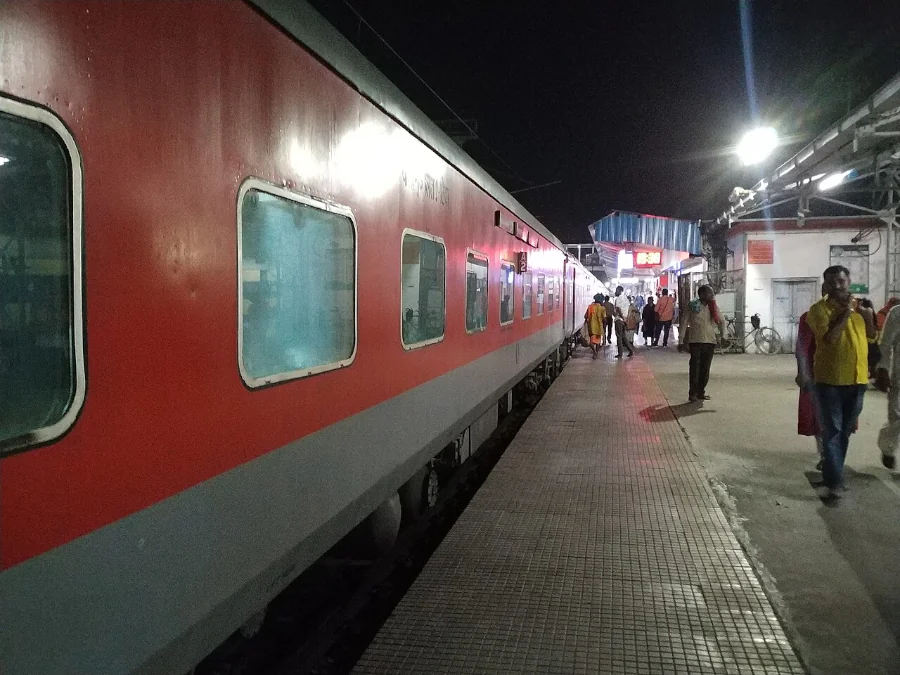
III. Road Networks
A. National Highways
➸ NH-19 (GT Road): Direct links to Delhi (768 km, 10h 46m), Kolkata (580 km, 12h) and Prayagraj (200 km, 3h).
➸ NH-35: Connects to Lucknow (300 km, 6h) via Sultanpur.
B. Bus Services
➨ State Transport (UPSRTC):
➸ Delhi → Mughalsarai: 15h; AC sleeper (₹1,100), Non-AC (₹600).
➸ Patna → Mughalsarai: 5h; semi-sleeper (₹350).
➨ Private Operators: RedBus services from Kolkata (12h; ₹800) and Lucknow (6h; ₹500).
C. Self-Drive/Rental Cars
➸ Delhi → Mughalsarai: 768 km via Agra–Lucknow Expressway (Toll: ₹850; Fuel: ₹5,500 for Diesel SUV).
➸ Varanasi → Mughalsarai: 25 km (45m; toll: ₹65).
➸ Rental Agencies: Zoomcar (Varanasi Airport; ₹12/km) and local providers (₹10/km with driver).
IV. Regional Travel Hubs
A. From Bihar
➸ Patna → Mughalsarai: 200 km via NH-19 (4h Drive); Trains like Garib Rath (2h 30m; ₹150 Sleeper).
B. From Madhya Pradesh
➸ Jabalpur → Mughalsarai: 550 km via NH-39 (10h drive); Bus + Train via Prayagraj (10h 5m; ₹8,650).
C. From Uttarakhand
➸ Dehradun → Mughalsarai: Trains like DDN DDU Express (14h); buses via Moradabad (16h).
V. Local Transport in Mughalsarai
➸ Auto-rickshaws: Intra-city fares ₹20 – ₹100 (e.g., Station → Ramgarh Tal: ₹50).
➸ Taxi Services: Varanasi Best Cab (₹15/km) and Ola (₹12/km).
➸ Cycle-rickshaws: Short distances (under 3 km); ₹30 – ₹40.
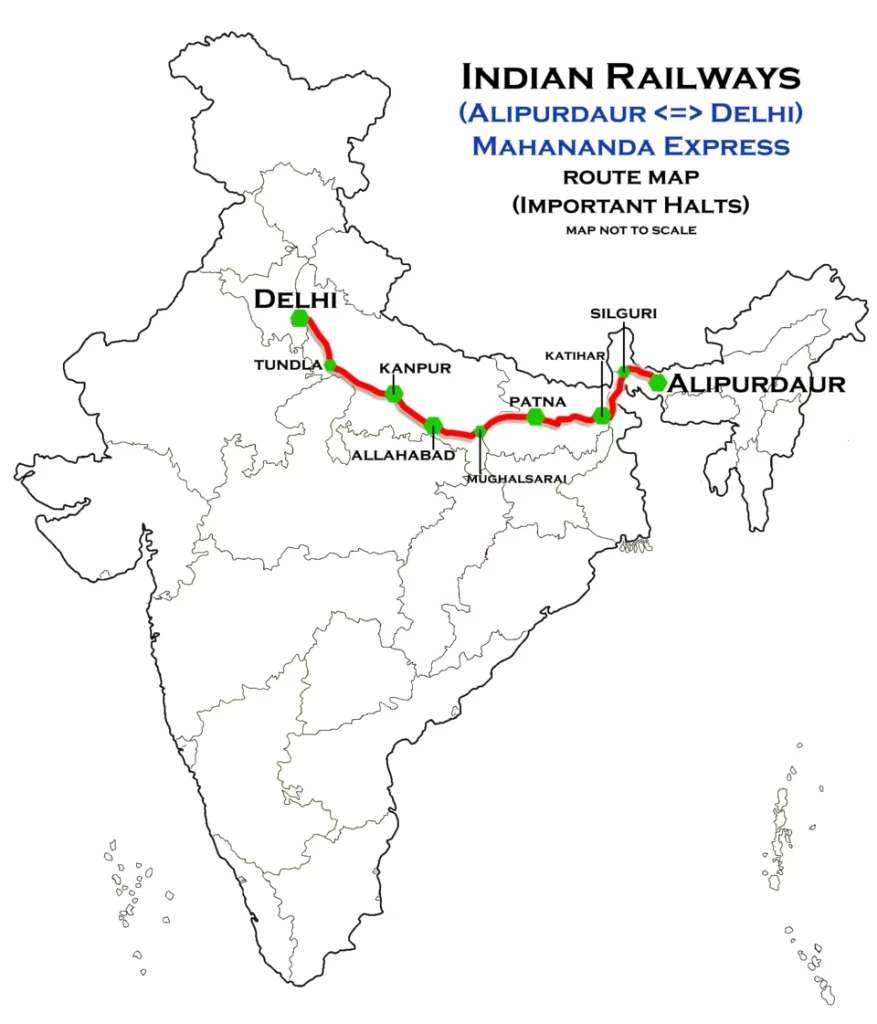
VI. Seasonal and Practical Tips
➨ Peak Travel Windows:
➸ October–March: Ideal for rail/road trips (18°C – 25°C); book trains 60 days ahead for Kumbh Mela/Sarnath festivals.
➸ Monsoons (July–September): Road delays likely; prioritise trains.
➨ Budget Hacks:
➸ Unreserved train coaches (₹50–100 for Short Hops).
➸ Shared autos to Varanasi (₹50/Person).
➨ Safety Notes:
➸ Avoid overnight road travel on NH-19 due to fog (December–January).
➸ Use prepaid taxis at stations.
Table: Best Transport Modes by Origin City
| Origin | Fastest Mode | Time | Cost (Approx) | Cheapest Mode |
| Varanasi | Local Train | 25 min | ₹ 20 | Shared Auto (₹ 50) |
| Kolkata | Howrah Rajdhani | 7 hrs | ₹ 1,900 | UPSRTC Bus (₹ 800) |
| Delhi | Vande Bharat Express | 7 hrs 45 min | ₹ 1,100 – ₹ 2,100 | Sleeper Train (₹ 415) |
| Mumbai | Mumbai Howrah Mail | 24 hrs | ₹ 2,700 (AC-2) | Non-AC Bus (₹ 1,200) |
VII. Special Considerations
➸ Rail Enthusiasts: Explore DDU’s Heritage Steam Locomotive Display near Platform 1 and Asia’s Largest Marshalling Yard (12.5 km long; guided tours unavailable but viewable from station).
➸ Pilgrims: Direct trains to Sarnath (14 km) and Varanasi; avoid unlicensed tour operators.
➸ Infrastructure Limits: No direct flights to Mughalsarai; Varanasi Airport lacks 24/7 food outlets—carry essentials.
VIII. Final Tips: Strategic Routing
Mughalsarai’s strength lies in its Rail Dominance, making trains optimal for efficiency. Air travellers must pivot through Varanasi, while road trips suit flexible explorers. From Delhi/Kolkata, prioritise Rajdhani trains; from Bihar/MP, use NH-19 buses. Always cross-check train codes (DDU, not MGS) post-renaming and monitor IRCTC for last-minute AC cancellations. With multimodal access, this transit hub seamlessly bridges India’s spiritual heartland (Varanasi) and eastern frontiers.

Best Places to Visit in and near Mughalsarai, Uttar Pradesh: A Granular Guide
Mughalsarai (officially Deen Dayal Upadhyaya Nagar) is a historic transit hub in eastern Uttar Pradesh, renowned for its Strategic Location on the Grand Trunk Road and the Busiest Railway Junction in India. While primarily a transportation nexus, the town and its surroundings offer a blend of historical, spiritual, and natural attractions. Below is a detailed exploration of Key Sites, with Precise Logistics, Cultural Context and Travel Tips.
I. Historical Landmarks
1. Chunar Fort (25 km Southwest)
Perched on a quartzite cliff overlooking the Ganges, this 11th-century fort blends Rajput, Mughal, and British architectural styles. Key features include:
➸ Babar’s Mosque: Built in 1525, with intricate Jali (Lattice) work.
➸ British-era Dungeons: Used to imprison rebels during the 1857 uprising.
➸ Viewpoints: Panoramic vistas of the river confluence.
⦿ Entry Fee: ₹25 for Indians; ₹300 for Foreigners.
⦿ Best Time: Sunrise/Sunset for Photography.
⦿ Auto-rickshaws from Mughalsarai: Cost ₹150 – ₹200 one-way.
2. Mughalsarai Junction
Asia’s Largest Marshalling Yard (12.5 km long) Handles 1,500 wagons daily. Highlights:
⦿ Heritage Steam Locomotive Display: Near Platform 1.
⦿ Rail Museum: Rare photographs of the East India Railway’s Howrah–Delhi line (1854).
👉 Tip: Use the station’s Retiring Rooms (AC: ₹500/night) for Short Stays.
II. Natural Escapes
1. Chandraprabha Wildlife Sanctuary (65 km West)
A biodiversity hotspot with:
⦿ Waterfalls: Rajdari (7-tier cascade) and Devdari (Monsoon-fed).
⦿ Wildlife: Asiatic Lions (reintroduced in 2021), Chinkara Deer, and 150+ Bird Species.
👉 Safari options: Jeep (₹400/Person) or Guided Trekking (₹200). Open 6 AM – 5 PM; Avoid Summer (45°C+).
2. Ramgarh Tal (8 km Northeast)
A serene reservoir ideal for:
⦿ Boating: Rowboats (₹100/hour) and paddle boats (₹150/hour).
⦿ Birdwatching: Migratory Siberian cranes (November–February).
👉 Nearby: Ramrekha Mandir, a cliffside temple with carved medieval idols.
III. Spiritual Sites
1. Katari Mata Ka Mandir (Central Mughalsarai)
Dedicated to the Tiger-riding Goddess, this 300-year-old temple features:
⦿ Blood-red Idols: Symbolising Shakti (Divine Feminine Power).
⦿ Navratri Festivals: Nightly Garba Dances and Floral offerings.
👉 Open: 5 AM – 10 PM; Darshan wait time: 20–40 minutes.
2. Gauria Math (3 km from Station)
A Vaishnavite monastery established in 1896, known for:
⦿ Manuscript Library: 15th-century Bhakti poetry texts.
⦿ Free Langar: Daily Khichdi Meals served at Noon.
IV. Nearby Excursions (Within 15 km)
1. Sarnath (14 km North)
Where Buddha delivered his first sermon. Key sites:
⦿ Dhamek Stupa: 43-m tall cylindrical structure with Gupta-era Carvings.
⦿ Archaeological Museum: Ashoka’s lion capital (India’s National Emblem).
👉 Entry: ₹30; Audio Guide: ₹150. Auto-rickshaw fare: ₹250 from Mughalsarai.
2. Varanasi Ghats (11–12 km Northwest)
Accessible via NH19 (30-minute drive):
⦿ Dashashwamedh Ghat: Famous for Ganga Aarti (6 PM Daily; Arrive 1 hour early).
⦿ Manikarnika Ghat: Cremation site; respect photography bans.
👉 Boat rides: ₹200/Person (Sunrise); ₹400 (Sunset).

V. Practical Visiting Strategies
➸ Seasonal Timing:
⦿ October–March: Ideal for wildlife and temples (Avg. 18°C).
⦿ Monsoons (July–September): Best for Chandraprabha’s waterfalls but avoid trekking.
➸ Transport:
⦿ Mughalsarai to Varanasi: Shared autos (₹50) or Ola cabs (₹300).
⦿ Local guides: Hire at Chunar Fort (₹200/tour) for Historical Insights.
➸ Cultural Etiquette:
⦿ Cover shoulders/knees at temples; remove shoes at Maths.
⦿ Avoid leather items at Vishwanath Temple (Varanasi).
VI. Hidden Gems
⦿ Bhardwaj Ashram: A riverside meditation centre near Ramgarh Tal, offering free yoga at dawn.
⦿ Subah-e-Banaras: Sunrise poetry sessions at Assi Ghat (Varanasi), 5:30 AM daily.
👉 Final Tips: Blending Transit with Exploration
Mughalsarai serves as both a functional base for train connections and a Gateway to Uttar Pradesh’s spiritual-natural corridor. Prioritise Chunar Fort for history, Chandraprabha for wilderness, and Varanasi for culture. With strategic day trips, even a 24-hour layover can encompass ancient stupas, jungle safaris, and river rituals — all within a 30-km radius. For deeper immersion, pair Mughalsarai’s simplicity with Varanasi’s intensity, using the junction’s retiring rooms for seamless transit.

Where to Stay in and near Mughalsarai, Uttar Pradesh, India: A Comprehensive Guide
Mughalsarai (officially known as Deen Dayal Upadhyaya Nagar) is a critical transit hub in eastern Uttar Pradesh, renowned for its Historic Railway Junction and proximity to Varanasi (25 km). Once a key Sarai (Rest House) on the Grand Trunk Road during the Mughal era, it now serves as a gateway for pilgrims and travellers exploring Varanasi’s spiritual sites. Accommodations here cater to diverse needs—from budget stays for transit passengers to luxury resorts in nearby Varanasi. Below is a detailed analysis of lodging options, with granular insights on amenities, locations, and strategic advantages.
I. Budget Hotels in Central Mughalsarai (Under ₹1,500/Night)
For travellers prioritising affordability and railway access, these hotels offer no-frills comfort:
➸ Hotel Gayatri Palace: Located near Subhash Nagar, this Guesthouse features Balconies with Courtyard Views, Basic AC Rooms and 24-hour check-in. Priced from ₹900/night, it’s ideal for solo backpackers.
➸ Hotel Saraswati: Situated in Nai Basti, it includes a Seasonal Swimming Pool and Restaurant. Rooms start at ₹812/night but note mixed reviews on cleanliness.
➸ Hotel Station View Mughalsarai: Just a 5-minute walk from Deen Dayal Upadhyaya Junction, this 3-star property offers AC rooms with private bathrooms. Despite its prime location, reviews highlight noise issues (Rating: 2.4/5 from 114 reviews).
Table: Budget Hotel Comparison
| Property | Price/Night | Distance to Station | Key Amenities |
| Hotel Station View | ₹ 1,497 | 0.3 km (Walkable) | AC, Private Bathroom |
| Hotel Gayatri Palace | ₹ 1200 | 2 km | Courtyard, Balcony |
| Hotel Saraswati | ₹ 1500 | 3 km | Pool, Restaurant |
II. Mid-Range Hotels (₹1,500–₹3,500/Night)
For enhanced amenities and business-friendly services:
➸ Spring Sky Mughalsarai: Part of the ShriGo chain, this hotel features a Fitness Centre, Bar and Multi-cuisine Restaurant. Executive rooms (from ₹4,425/night) include ergonomic workstations and high-speed Wi-Fi, catering to business travellers.
➸ Hotel PSK INN: Notable for its Fireplace and Butler Service (Rare in this Category). Priced at ₹3,239/night, it receives high marks for Hospitality (Rating: 4.3/5).
➸ The Park Green Hotel & Resort: A new entrant with 24-hour Room Service and landscaped gardens. Rooms from ₹3,150/night include buffet breakfast.
III. Premium Stays Near Mughalsarai (Chandauli & Varanasi)
Travellers seeking luxury should consider these nearby areas:
➸ Ramada by Wyndham Varanasi Katesar (Chandauli): A 4-star resort 4.4 miles from Varanasi, featuring a pool, spa, and tropical gardens. Prices start at ₹5,900/night. Guests praise its “Oasis of Calm” Ambiance and Airport shuttle.
➸ Rangili Baag (Varanasi): A heritage villa near Kashi Vishwanath Temple, blending traditional Architecture with modern luxuries like a Swimming Pool. Rates from ₹4,000/night.
➸ NAMO Guest House (Varanasi): Exclusively for Indian nationals, it offers CCTV security and terrace views of the Ganges. At ₹961/night, it’s a steal for families.

IV. Strategic Location Insights
➸ Railway Proximity: Hotels like Hotel Station View and Gulmohar Plaza (Railway Colony) are optimal for early-morning Train Departures.
➸ Spiritual Access: Properties like Rangili Baag provide easy access to Varanasi’s Ghats (e.g., Manikarnika Ghat is 9 miles from Mughalsarai).
➸ Airport Connectivity: Lal Bahadur Shastri International Airport (38 km) is served by shuttles from Ramada and The VIA VARANASI Resort.
V. Seasonal and Booking Tips
➸ Peak Seasons: October–March sees high demand for Kumbh Mela and winter tourism. Book 3+ months early via platforms like MakeMyTrip (offering 70% Discounts with Coupon Codes).
➸ Budget Tricks: Non-AC rooms drop to ₹652/Night in Summer (April–June), but confirm water supply due to seasonal shortages.
➸ Transport: Auto-rickshaws charge ₹50 – ₹100 for Intra-city Travel; pre-paid Taxis to Varanasi cost ₹500 – ₹800.
VI. Critical Considerations
➸ Noise Sensitivity: Avoid hotels along GT Road; opt for inner-lane properties like Spring Sky.
➸ Pilgrim Needs: Bhardwaj Darbar offers Bonfire Evenings and Vegetarian Meals, Aligning with Cultural Practices.
➸ Safety: Solo travellers prefer NAMO Guest House for its CCTV and 24-hour staff.
👉 Final Tips: Aligning Stays with Travel Goals
Mughalsarai excels as a practical transit base, while Varanasi/Chandauli provide Cultural Immersion. Budget travellers will find Mughalsarai’s railway-adjacent hubs efficient, but luxury seekers should venture nearer to Varanasi’s riverfront heritage. Prioritise recent reviews (2024–2025) due to rapid infrastructure changes, and leverage booking sites like Goibibo for last-minute deals with free cancellation. Whether you’re a pilgrim, business commuter, or heritage enthusiast, granular planning ensures a seamless stay in this historic corridor.

Best Places for Refreshments with Authentic Local Food in Mughalsarai, Uttar Pradesh: A Granular Culinary Guide
Mughalsarai (officially Deen Dayal Upadhyaya Nagar) is a historic transit hub where North India’s culinary traditions converge, blending Persian, Mughal, and Awadhi influences into a vibrant street food culture and hearty home-style meals. Renowned for its Chaat, Kebabs, and Biryanis, the city offers diverse refreshment spots—from railway-side kiosks to heritage hotel kitchens—that deliver authentic flavours rooted in local rituals. Below is a meticulously detailed exploration of the top venues for traditional refreshments, with granular insights on dishes, pricing, timings, and cultural context.
I. Railway Junction Eateries: Fast Bites for Transit Passengers
Pandit Deen Dayal Upadhyaya Junction (Asia’s largest marshalling yard) hosts bustling food stalls catering to travellers with regional specialties:
➸ Platform 1–3 Snack Kiosks: Vendors serve Crispy Kachoris (₹20 each) stuffed with Spiced Lentils and accompanied by tangy Tamarind Chutney and Steaming Samosas (₹15) filled with potato-pea masala. Open 24/7, these stalls prioritise speed without compromising freshness.
➸ Station Food Plaza: Features Railway Thalis (₹120 – ₹150) with Dal, Seasonal Sabzi, Roti and Rice. The Mutton Biryani (₹280) here uses aromatic Gobindobhog Rice and slow-cooked Meat, reflecting Mughal techniques.
➸ Swiggy Delivery for Trains: Order Local Favourites like Chhole Bhature (₹90) or Veg Pulao (₹70) via Swiggy—designate “PDDU Junction” as the drop point for delivery to specific platforms.
II. Heritage Hotel Dining: Traditional Flavours in Refined Settings
ShriGo Hotels – Spring Sky Mughalsarai stands out for its curated local menu in a polished ambiance:
➸ Signature Dishes: Mutton Rogan Josh (₹320) slow-simmered in Fennel-infused gravy and Paneer Lababdar (₹240) featuring Cottage Cheese in a Cashew-Tomato sauce. Served with “Chur Chur Naan” (₹50), a flaky, buttery flatbread.
➸ Cultural Experience: Evening Bonfire Gatherings with live folk music (October–March), paired with Regional Desserts like Gajar Ka Halwa (₹120) or Rabri (₹80).
➸ Practical Details: Open 7 AM – 11 PM; Advance Booking Recommended for Dinner. Combines Air-conditioned comfort with traditional Brassware serving platters.
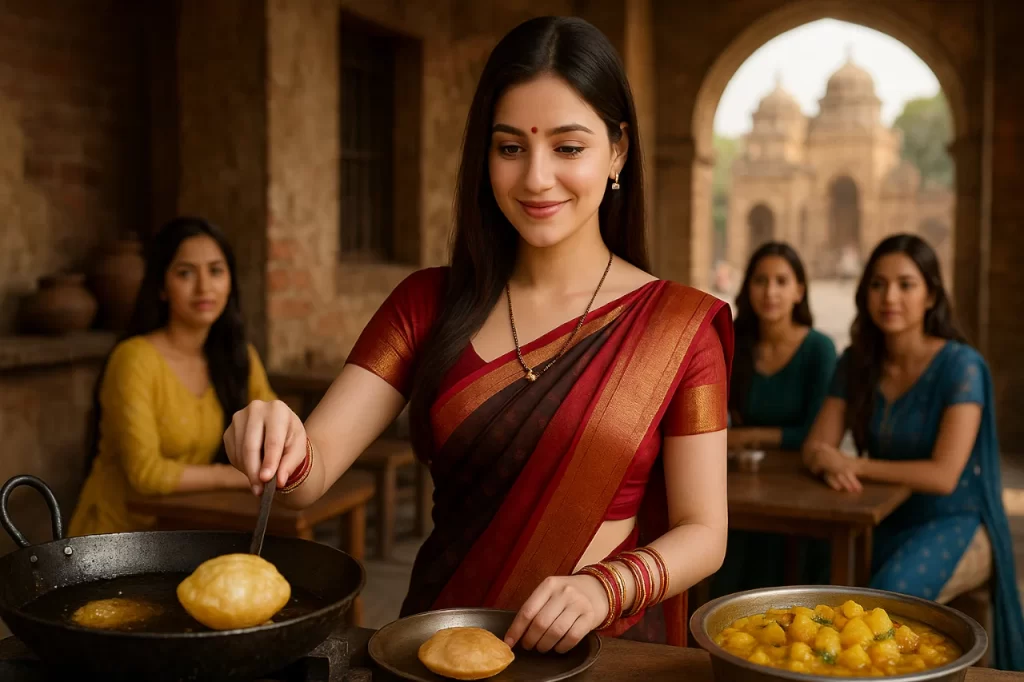
III. Street Food Hubs: Chaotic Charm and Iconic Snacks
A. Katari Mata Mandir Precinct
Near the 300-year-old temple, stalls offer Devotional Snacks aligned with rituals:
➸ Prasad Thalis (₹50): Includes Dahi Vada, Besan Laddoo and Seasonal Fruit.
➸ Evening Specials: Jalebi (₹40/100g) fried in ghee and spiced Chai (₹10) served in clay Kulhads.
👉 Best Time: 4–7 PM during Aarti.
B. Ramgarh Tal Lake Area
Lakeside vendors capitalise on sunset crowds:
➸ Fish Fry (₹60/piece): River-caught Rohu marinated in Mustard-Turmeric Paste.
➸ Birdwatcher’s Breakfast: Poha (Flattened Rice with Peanuts, ₹30) and Sabudana Khichdi (Tapioca Pearls, ₹40) served at Dawn.
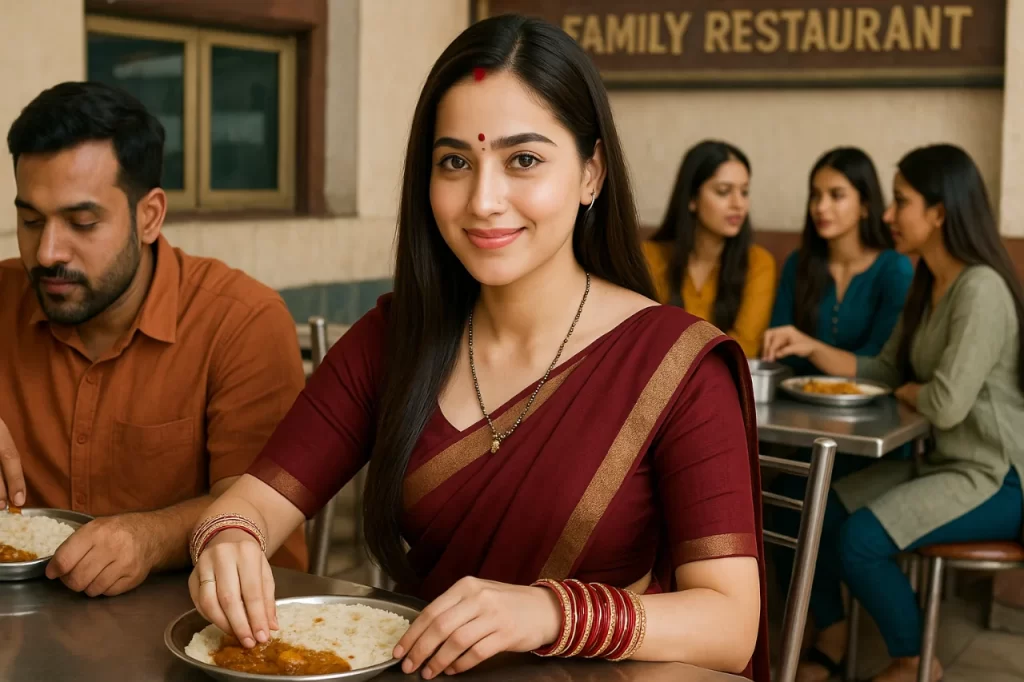
IV. Tea Culture: Chai Stalls as Social Epicentres
Mughalsarai’s neighbourhoods feature prolific Tea stalls (Tapris), each with distinct offerings:
➸ GT Road Tapris: Focus on Masala Chai (₹10) boiled with Ginger-Cardamom and Biscuit pairings (₹5).
➸ Specialty Brews: “Thandai” (₹50) during Holi — a cooling Saffron-milk punch with Almonds — and Kadak Adrak Chai (Strong Ginger Tea, ₹15) for Winter Mornings.
👉 Notable Spot: Bhardwaj Tea Corner near Gauria Math, known for its 40-year-old brass kettle.
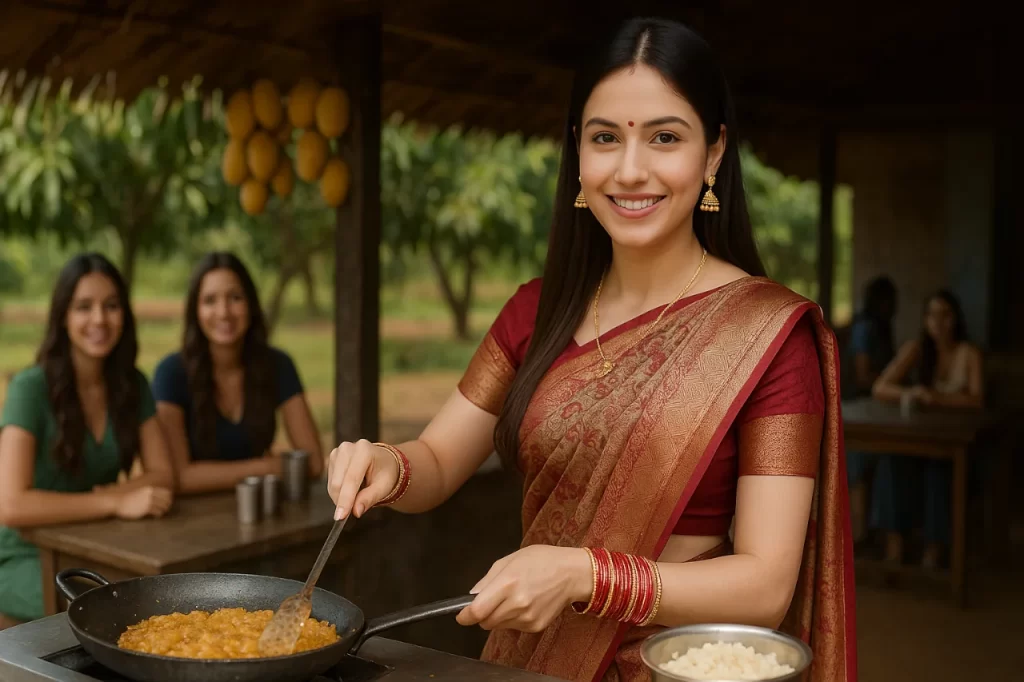
V. Vegetarian Havens: Temple Bhojanalayas and Maths
Gauria Math (Vaishnavite Monastery) serves spiritually aligned meals:
➸ Free Langar: Daily noon Khichdi (Rice-lentil Porridge) with Papad and Pickles. Donations accepted.
➸ Festival Feasts: During Janmashtami, expect Chappan Bhog (56-dish Platter) including Puri, Kheer, and Aloo Sabzi.
👉 Rules: Shoes removed; Pure Vegetarian.
VI. Meat Lovers’ Corners: Mughal-Inspired Kebabs and Biryanis
➸ Railway Colony Night Stalls: After 8 PM, carts sell Seekh Kebabs (₹120/plate) minced with raw papaya for tenderness, and Bottled Roughani Chutney (Mint-oil Sauce, ₹30).
➸ Family-Run Canteens: Rahim Biryani House near Subhash Nagar offers “Kolkata-style” Biryani (₹150) with Potato and Boiled Eggs, using Mutton from daily market purchases.
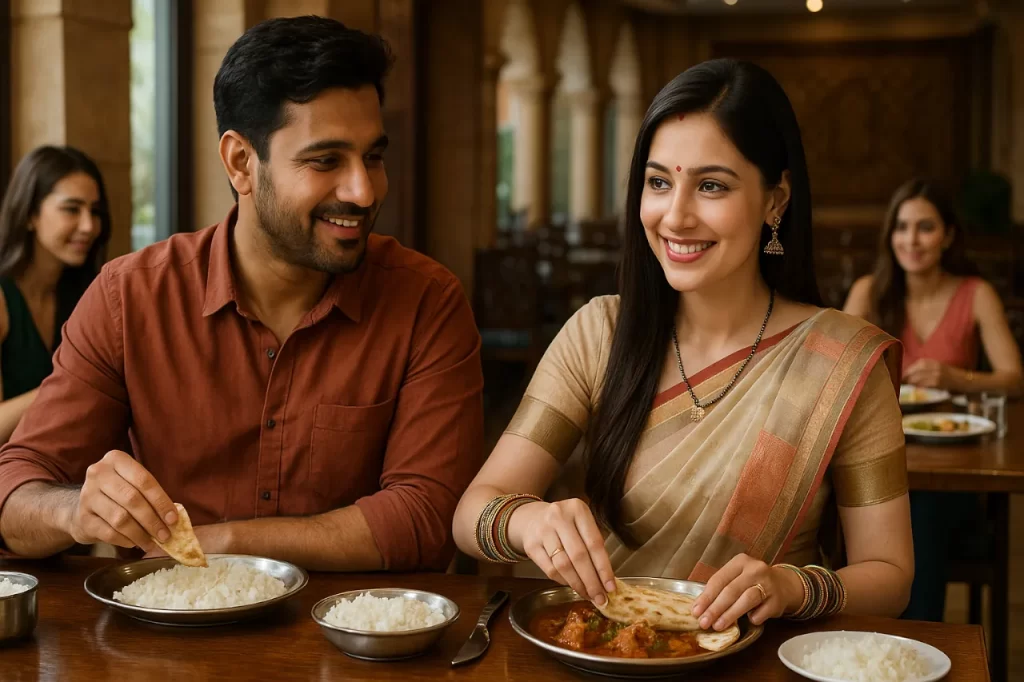
VII. Sweet Sanctuaries: Mithai Shops with Legacy Recipes
➸ Gurukul Mithai Wala: Famous for Motichur Laddoos (₹400/kg) using Desi Ghee and Kalakand (Milk Fudge, ₹350/kg) set on mango leaves.
➸ Seasonal Specials: Malai Gilori (₹25/piece) — cream-filled pancakes during Diwali—and Hot Gulab Jamun (₹120/half-dozen) served with Rabri in Winter.
VIII. Practical Tips for Food Exploration
➸ Timings: Street stalls peak 7–10 AM and 4–8 PM; restaurants serve until 11 PM.
➸ Budget: Full meals cost ₹80 – ₹150 (Streets), ₹200 – ₹500 (Hotels).
➸ Etiquette: Eat with right hand at street stalls; avoid meat/alcohol near temples.
➸ Booking: Swiggy delivers 70+ local dishes ; use filter “Ratings 4.0+” for quality assurance.
Table: Signature Dishes & Where to Find Them
| Dish | Venue | Price | Unique Feature |
| Mutton Rogan Josh | Spring Sky Mughalsarai | ₹ 320 | Slow-cooked in Sealed Handi |
| Kachori-Sabzi | PDDU Junction Platform 3 | ₹ 20 | Served with Tamarind-Jaggery Dip |
| Fish Fry | Ramgarh Tal Vendors | ₹ 60 | Marinated in Mustard Oil |
| Thandai | GT Road Tea Stalls (March) | ₹ 50 | Served with Bhang Option |
| Malai Gilori | Gurukul Mithai Wala (October – November) | ₹ 25 | Edible Silver Leaf Garnish |
IX. Final Tips: Savouring History in Every Bite
Mughalsarai’s refreshment spots are microcosms of its Mughal-era Hospitality Legacy, where every Kebab, Chai and Mithai carries centuries of culinary adaptation. For transit travellers, the junction’s stalls deliver efficiency; for cultural immersion, ShriGo’s bonfire feasts or Gauria Math’s Langar offer deeper connections. Prioritise seasonal specialties (Monsoon Pakoras, Winter Gajar Halwa), and leverage Swiggy for late-night cravings. In this city—where Grand Trunk Road travellers once refuelled — the authentic flavours persist, now enjoyed with modern convenience but undiminished heritage.

Climatic Conditions in Mughalsarai, Uttar Pradesh, India: A Granular Analysis
Mughalsarai (officially Deen Dayal Upadhyaya Nagar) experiences a Humid Subtropical Climate characterised by extreme seasonal variations in temperature, precipitation, and humidity. Located in eastern Uttar Pradesh at 25.28°N latitude and 83.12°E longitude, its weather is influenced by the Gangetic Plains and the Bay of Bengal monsoon systems. Below is a detailed examination of its climatic parameters, leveraging longitudinal data and comparative analysis.
I. Annual Temperature Profile
Mughalsarai exhibits three distinct thermal seasons:
➸ Hot Season (April–June): Peak temperatures in May average 105°F (40.5°C), with lows of 79°F (26°C). Record highs reach 112°F (44.4°C), particularly in late May.
➸ Monsoon Season (July–September): Daytime highs drop to 93°F (34°C), but nighttime lows remain elevated (80–82°F / 27–28°C), creating oppressive conditions.
➸ Cool Season (December–February): January is coldest (avg. high 73°F / 23°C; avg. low 50°F / 10°C). Frost is absent, but fog reduces visibility to ≤1 km on 15–20 days annually.
Table: Monthly Temperature Averages
| Month | Avg. High | Avg. Low | Record High | Record Low |
| March – June | 105°F (40.5°C) | 79°F (26°C) | 112°F (44.4°C) | 72°F (22°C) |
| July – October | 93°F (34°C) | 80°F (27°C) | 106°F (41°C) | 75°F (24°C) |
| November – February | 73°F (23°C) | 50°F (10°C) | 85°F (29°C) | 44°F (7°C) |
II. Monsoon Dynamics and Rainfall
The southwest monsoon (June–September) delivers 90% of Mughalsarai’s annual rainfall:
➸ Onset: Around June 15, with cloud cover surging from 17% to 64% within weeks.
➸ Peak Precipitation: July receives 8.2 inches (208 mm) over 19 rainy days, while August follows closely with 7.6 inches (193 mm).
➸ Rainfall Intensity: Maximum hourly rainfall reaches 2.0 inches (50 mm) during July thunderstorms, often causing urban flooding in low-lying areas like Ramgarh Tal.
➸ Dry Months: November–February average ≤0.2 inches (5 mm) monthly, with rain on ≤2 days.
III. Humidity and Muggy Conditions
Humidity extremes define liveability:
➸ Pre-Monsoon (April–June): Relative humidity plunges to 21–36% in April–May, intensifying heat stress.
➸ Monsoon (July–September): Humidity soars to 73–79%, with dew points consistently ≥80°F (27°C). August experiences 31 “Muggy Days” (feels-like ≥104°F / 40°C).
➸ Post-Monsoon (October): Humidity drops to 60–65%, though residual moisture fuels morning fog.
IV. Solar Radiation and Daylight Hours
➸ Sun Exposure: March–June averages 9–10 hours of daily sunshine, dropping to 3–4 hours in July–August due to cloud cover.
➸ Daylight Duration: Varies from 10h 34m (December Solstice) to 13h 43m (June solstice). The June 21 sunrise is at 5:07 AM, sunset at 6:50 PM.
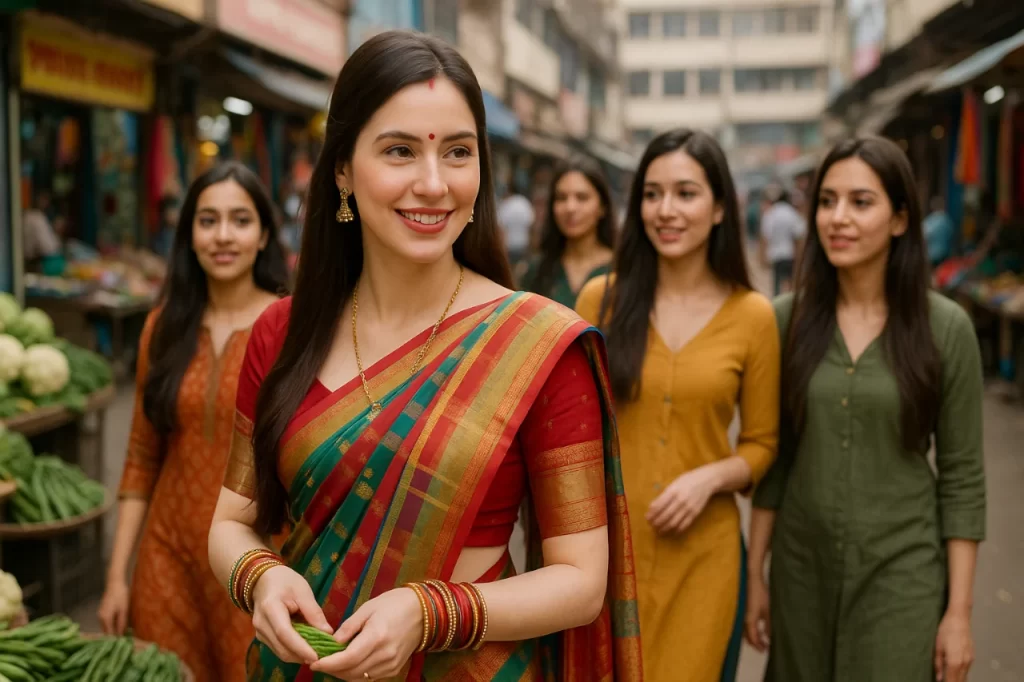
V. Wind Patterns and Air Quality
➸ Summer Winds (May–June): Westerlies dominate at 12.1 mph (19.5 kph), providing minimal cooling.
➸ Monsoon Winds (July): Shift to easterlies at 11.6 mph (18.7 kph), carrying moisture from the Bay of Bengal.
➸ Air Quality: PM2.5 levels peak in November–January (AQI 250–300) due to agricultural burning and thermal inversion.
VI. Seasonal Breakdown with Travel Implications
1. Pre-Monsoon (March–Mid-June)
➸ Conditions: Intense heat (avg. 102–105°F / 39–40.5°C), low humidity, and dust storms.
➸ Risks: Heatstroke probability exceeds 40% for outdoor activities between 11 AM – 3 PM.
➸ Adaptation: Hydration critical; lightweight cotton clothing recommended.
2. Monsoon (Late June–September)
➸ Conditions: Torrential rains (≥6 inches monthly), 80% cloud cover, and reduced visibility.
➸ Risks: Highway flooding on NH-19; train delays averaging 4–6 hours at DDU Junction.
➸ Adaptation: Waterproof gear essential; monitor real-time flood alerts via Ventusky.
3. Post-Monsoon (October–November)
➸ Conditions: Pleasant temps (68–90°F / 20–32°C), clear skies, and harvest-season air pollution.
➸ Opportunities: Ideal for Chandraprabha Wildlife Sanctuary visits; bird migration peaks.
4. Winter (December–February)
➸ Conditions: Dry, foggy mornings (visibility ≤1 km until 10 AM); daytime highs 72–75°F (22–24°C).
➸ Adaptation: Layered clothing; rail/road travel requires fog contingency planning.
VII. Extreme Weather Events
➸ Heatwaves (May): 5–7 annual days ≥111°F (44°C). June 15, 2024, hit 115°F (46°C).
➸ Floods (July–August): 2013 and 2020 recorded 15.6 – 16.9 inches rainfall in 72 hours, submerging Railway Colony.
➸ Drought Cycles: 5-year recurrence of April–May dry spells (≤0.2 inches rain), straining groundwater.
VIII. Climate-Responsive Travel Planning
➸ Optimal Visits: February–March (Spring Harvest Festivals) and October–November (Post-monsoon clarity).
➸ Avoid: Late June–August (Monsoon Disruptions) and May (Extreme Heat).
➸ Health Precautions:
☀️ Summer: Electrolyte replenishment; UV-protective clothing (UV Index 10–12).
🌧️ Monsoon: Anti-leech socks for Chandraprabha treks; water purification tablets.
IX. Climate Change Trends
Since 2000, Mughalsarai has witnessed:
➸ Temperature Rise: +1.8°F (1°C) in May averages.
➸ Rainfall Volatility: 30% increase in July rainfall intensity, but 15% fewer rainy days.
➸ Phenological Shifts: Mango flowering now begins mid-February vs. March in the 1990s.
👉 Final Tips: Navigating a Climate of Extremes
Mughalsarai’s climate demands strategic adaptation—whether enduring Summer’s Furnace-like Heat, Monsoon’s waterlogged streets, or Winters foggy stillness. Its weather patterns reflect the Broader Volatility of the Gangetic Plain, where Agricultural Rhythms and Transport logistics remain tethered to atmospheric shifts. For travellers, aligning visits with the Golden windows of October–November or February–March ensures safer exploration, while infrastructure planners must prioritise flood-resilient designs to counter increasingly erratic monsoons. Real-time tools like Ventusky’s hyperlocal forecasts provide critical updates for navigating this meteorologically complex region.
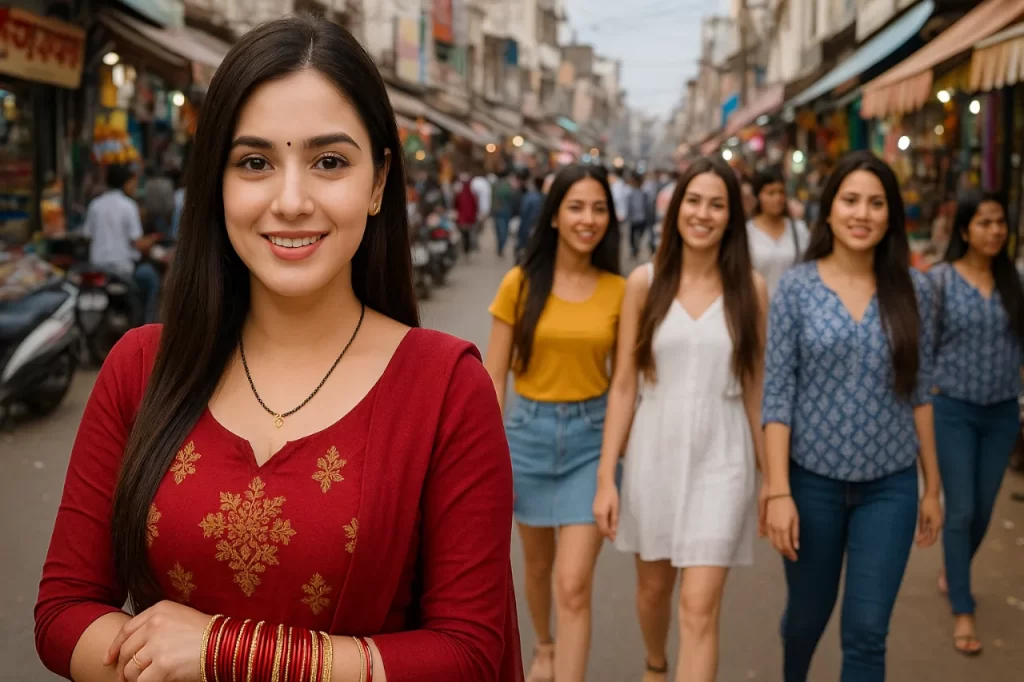
Sociocultural Mosaic of Mughalsarai: Castes, Tribes, and Languages
I. Demographic and Geographic Context
Mughalsarai (officially Pandit Deen Dayal Upadhyaya Nagar) is a municipal board in Chandauli district, eastern Uttar Pradesh, with a population of 109,650 (2011 Census). The city exhibits a gender distribution of 57,682 Males and 51,968 Females, with a sex ratio of 901 Females per 1,000 Males — below the state average. Scheduled Castes (SCs) constitute 16.4% (17,943 people), while Scheduled Tribes (STs) form 1.9% (2,093 people) of the population. Historically a transit hub on the Grand Trunk Road (NH-19) and home to Asia’s fourth-busiest railway junction, Mughalsarai’s demography reflects migrations linked to trade and railway employment since 1883.
II. Scheduled Castes (SCs): Structure and Distribution
SCs in Mughalsarai belong primarily to the Chamar-Jatav subgroup (54% of SCs statewide), traditionally associated with leatherwork and agriculture. Key SC communities include:
➸ Pasi: Engaged in Palm-tapping and Farming, concentrated in Ramgarh Tal and Alampur.
➸ Dhobi: Specialising in laundry services, clustered near water bodies like the Ganges tributaries.
➸ Kori/Balarami: Weavers and daily-wage labourers residing in Qassab Mohal and Subhash Nagar.
SC literacy rates (70.2% overall) lag behind city averages (81.2% for ages 7+), with female literacy at 63.7% versus male literacy of 76.0%. Politically, SCs hold 18.31% representation in the Mughalsarai Assembly constituency.
III. Other Backward Classes (OBCs) and Upper Castes
➸ OBCs: Dominated by Yadavs (Pastoralists) and Kurmis (Farmers), forming electoral majorities in rural Gram Panchayats like Dharamshala and Taranpur. The Bania (Trading Community) controls grain markets like Galla Mandi.
➸ Upper Castes: Brahmins (Priestly Class) and Rajputs (Landowners) inhabit posh colonies like Kailashpuri and Ravinagar. They historically administered local temples like Katari Mata Mandir.
IV. Scheduled Tribes (STs): Niche Communities
Though STs comprise only 1.38% of the assembly constituency, Mughalsarai hosts:
➸ Kharwar: Originally forest-dwellers from Sonbhadra, now working in railway construction. Speak a Hindi-Khariboli hybrid and worship Shiva/Durga.
➸ Chero: Descendants of medieval rulers, employed in NH-19 road maintenance. Subdivided into Mahto (landowners) and Chaudhary (labourers).
➸ Agariya: Salt workers migrating seasonally from Mirzapur. Practice Foot-burning rituals for spiritual protection.
Table: Caste and Tribal Distribution
| Community | Population Share | Primary Occupations | Cultural Practices |
| Chamar – Jatav (SC) | 54% of SCs | Leathercraft, Agriculture | Kabir Panth Devotionalism |
| Yadav (OBC) | ~22% of OBCs | Dairy Farming, Politics | Holi Cattle Festivals |
| Kharwar (ST) | 0.9% | Railway Labor, Forestry | Jeevit Putrika Fasting |
| Brahmin (Upper) | ~8% | Priesthood, Education | Sanskrit Recitations |
V. Linguistic Diversity: Official and Vernacular Tongues
Hindi (Devanagari script) and Urdu (Nastaliq script) are Co-official languages. Urdu thrives near Mughalsarai Junction due to historical Muslim settlements like Qassab Mohal. The vernacular landscape is dominated by:
➸ Bhojpuri: Spoken by 65–70% of locals, especially in eastern wards like Amoghpur and Pashurampur. Features nasalised vowels and verb conjugations like “Haï” (is) and “Jaït Rahīl” (will go).
➸ Khariboli: Used in western colonies like Diesel Colony, showing influence from Delhi/Punjabi dialects (e.g., “Ho Jāo” instead of Bhojpuri “Ho Jav”).
VI. Dialectical Subregions and Literary Heritage
➸ Awadhi Influence: In Varanasi-proximate areas like Roza Colony, loanwords like “Panwa” (Betel) and “Jhoomar” (Dance) permeate daily speech.
➸ Bagheli Elements: In southern villages like Saresar, Bagheli verbs like “Karat” (Doing) appear, borrowed from Chitrakoot migrants.
Literary traditions include:
➸ Bhojpuri folklore by Bhikhari Thakur (e.g., “Bidesiya”) performed at Ramgarh Tal melas.
➸ Urdu poetry recitals at Gauria Math, echoing Ghalib’s Ghazals.
VII. Socioeconomic Dynamics and Language
➸ Education: Hindi-medium schools (e.g., Railway Colony School) enroll 89% of students, while Urdu madrasas cater to Qassab Mohal’s Muslim children. English fluency is ≤12%.
➸ Employment: Bhojpuri/Khariboli dominates informal sectors (e.g., Auto-rickshaw Drivers, Station Vendors), while Hindi/Urdu is used in municipal offices and railway administration.
➸ Religion-Language Links:
⦿ Hindus: Use Sanskritised Hindi for prayers at Katari Mata Mandir.
⦿ Muslims: Employ Urdu-Arabic blends in prayers at Mughalsarai’s Jama Masjid.
VIII. Cultural Synthesis and Modern Challenges
Mughalsarai’s identity merges Mughal-era Urdu legacy (evident in place names like “Sarai”) with Bhojpuri Rural Roots. Contemporary shifts include:
➸ Language Politics: Agitations for Bhojpuri’s Inclusion in the Eighth Schedule of the Constitution, led by groups like the Bhojpuri Sangh.
➸ Caste Mobilisation: Jatavs and Yadavs leverage Electoral Representation (e.g., BJP MLA Ramesh Jaiswal) to challenge upper-caste dominance.
➸ Urbanisation Effects: Railway migration dilutes tribal languages like Kharwar, with ≤40% of youth retaining native vocabulary.
IX. Final Thoughts: A Microcosm of Eastern UP’s Diversity
Mughalsarai epitomises Uttar Pradesh’s multilayered social fabric, where caste hierarchies intersect with linguistic pluralism. Its SC/ST communities navigate economic transitions—from agrarian work to railway jobs—while Bhojpuri remains the emotional lingua franca despite Hindi’s institutional dominance. As renaming debates (e.g., “Deen Dayal Upadhyaya Nagar”) highlight identity tensions, the city’s vitality lies in its ability to sustain syncretic traditions: Urdu poets reciting in temple courtyards, Kharwar tribes celebrating Holi with Chamar communities, and Bhojpuri ballads echoing across NH-19’s Truck Stops.

Notable Personalities of Mughalsarai (Deen Dayal Upadhyaya Nagar): Legacy and Contributions
I. Historical Foundations and Cultural Context
Mughalsarai (officially Pandit Deen Dayal Upadhyaya Nagar) has served as a strategic crossroads since the Mughal era, evolving from a Sarai (Rest House) on Sher Shah Suri’s Grand Trunk Road (NH-19) into a modern railway nexus. Its location fostered a unique blend of Bhojpuri Folk Traditions, Islamic Administrative Heritage, and Railway Colony Cosmopolitanism. While the city itself lacks monumental Historical Sites, its human capital — Spanning Politics, Social Reform, and Cultural Resilience—shaped Regional and National narratives.
II. Lal Bahadur Shastri (1904–1966): India’s Humble Prime Minister
Born in Mughalsarai on October 2, 1904, Lal Bahadur Shastri emerged from poverty to become India’s second Prime Minister:
➸ Freedom Struggle: Joined Gandhi’s Non-Cooperation Movement at 16, abandoning formal education. Jailed seven times by British authorities for leading civil disobedience campaigns.
➸ Governance Legacy: As Railway Minister (1952–1956), he Resigned Voluntarily after a fatal train accident in 1956, setting unprecedented ethical standards. Instituted third-class coach improvements and staff welfare reforms.
➸ Prime Ministership: Coined the iconic slogan “Jai Jawan, Jai Kisan” during the 1965 India-Pakistan war, linking soldier and farmer welfare. Died in Tashkent under mysterious circumstances in 1966.
➸ Personal Symbolism: Married Lalita Devi with a Spinning Wheel as Sole Dowry, Embodying Gandhian Simplicity. His birthplace is now the Lal Bahadur Shastri Memorial.
III. Political Leaders and Electoral Influence
A. Deendayal Upadhyaya (1916–1968): Ideological Icon
Though not a native, his death at Mughalsarai Junction in 1968 cemented his local legacy:
➸ Philosophical Impact: As Bharatiya Jana Sangh leader, articulated “Integral Humanism” — a socio-economic model blending Indian spirituality with decentralised governance.
➸ Renaming Controversy: The 2018 renaming of Mughalsarai to “Deen Dayal Upadhyaya Nagar” honoured his death here, erasing the Mughal-era toponym.
B. Contemporary Representatives
➸ Ramesh Jaiswal (BJP MLA): Elected from Mughalsarai Assembly constituency in 2022, focusing on railway infrastructure upgrades and OBC welfare.
➸ Sonu Kinnar (Municipal Chairperson): Independent transgender leader elected in 2023, advocating for sanitation reforms and LGBTQ+ rights in Railway Colonies.
IV. Religious and Cultural Figures
A. Katari Mata Mandir Guardians
➸ Priest Dynasty of Bhardwajs: A Brahmin family maintaining the 300-year-old Katari Mata Mandir since 1720. Conducts Navratri Blood-orange Rituals symbolising Shakti (Divine Feminine Power).
B. Syncretic Spiritual Voices
➸ Kabir’s Influence: While based in Varanasi, the 15th-century poet’s verses rejecting Hindu-Muslim divisions resonate in Mughalsarai’s Dargahs and Temples. Annual Kabir Panth gatherings occur at Gauria Math.
V. Literary and Artistic Connections
Though no major literary figures originated here, Mughalsarai’s culture absorbed influences from nearby centres:
➸ Ghalib’s Echoes: Mirza Ghalib (1797–1869) traveled the Grand Trunk Road, inspiring Urdu poets at Mughalsarai’s Jama Masjid. His couplets on existential angst remain quoted in local Mushairas (Poetic Symposia).
➸ Majrooh Sultanpuri (1919–2000): The lyricist from Sultanpur (120 km away) influenced Bhojpuri cinema themes. Mughalsarai’s folk theatres perform his hit songs like “Chahunga Main Tujhe”.
VI. Railway Community Pioneers
The Pandit Deen Dayal Upadhyaya Junction (Asia’s largest marshalling yard) bred unsung heroes:
➸ Engineer L.N. Verma (1935–2010): Designed the yard’s automated wagon classification system (1972), cutting coal transport delays by 70%. Awarded the Railway Minister’s Medal in 1988.
➸ Union Leader Shyam Sundar (1928–2005): Founded the Rail Mazdoor Sangh in 1954, securing housing rights for 10,000 railway families in colonies like Diesel Colony and Shubhash Nagar.
VII. Contemporary Voices
➸ Mohammad Affan (B. 1939): Oral historian documenting Mughalsarai’s Sarai era through Grand Trunk Road ballads. Published “Sadak-e-Azam ke Geet” (2015) with 200+ folk songs.
➸ Dr. Anjali Yadav (B. 1982): First female physician from the Pasi (SC) community. Runs a clinic in Ramgarh Tal, specialising in arsenic poisoning from local Groundwater.
VIII. Sporting Talent
➸ Vijay Kumar (b. 1995): National-level kabaddi player from Diesel Colony. Captained Uttar Pradesh’s team in the 2022 Kabaddi Federation Cup, employing the “Mughalsarai Chain Tackle” technique.
IX. The Naming Controversy: Identity Politics
The 2018 renaming ignited debates reflecting cultural erasure:
➸ Historical Basis: “Mughalsarai” originated in 1883 when British railways established the junction, referencing Sher Shah Suri’s 16th-century rest houses (Sarais)—not Mughal rule.
➸ Political Motivations: BJP leaders like Mukhtar Abbas Naqvi framed renaming as “Freeing History from Mughal legacies”, while critics like Samajwadi Party’s Naresh Agrawal called it “Anti-constitutional”.
➸ Local Sentiment: Elderly residents like Ramlakhan Verma lament lost heritage: “Mughalsarai wasn’t about emperors — it meant Travellers’ Rest”.
X. Final Thoughts: A Microcosm of India’s Soul
Mughalsarai’s legacy lies not in grand monuments but in its people: Shastri’s Ethics, Railway Engineers’ Ingenuity and Poets preserving Bhojpuri oral traditions. Its identity struggle—between “Mughalsarai” and “DDU Nagar” — mirrors India’s Broader Cultural Negotiations. As the junction still channels 1,500 freight wagons daily, its human stories remain the true cargo of History, urging recognition beyond political renaming.

Industrial Development and Industries in Mughalsarai (Deen Dayal Upadhyaya Nagar), Uttar Pradesh: A Granular Analysis
I. Historical Foundations and Economic Evolution
Mughalsarai (officially Pandit Deen Dayal Upadhyaya Nagar) has evolved from a Mughal-era Transit Hub on Sher Shah Suri’s Grand Trunk Road (NH-19) into a modern industrial-logistics nexus. Its industrial identity was catalysed by the establishment of the Pandit Deen Dayal Upadhyaya Junction in 1883, which became Asia’s largest marshalling yard (12.5 km long) and India’s fourth-busiest railway station, handling 1,500+ freight wagons daily.
Historically, the city served as a Sarai (Rest House) for traders transporting textiles, spices, and precious metals during the Mughal period, leveraging its strategic location between North and East India. Post-1883, railway infrastructure transformed it into a critical node for Coal, Grain and Raw Material Logistics, laying the groundwork for Ancillary Industries.
II. Core Industrial Sectors and Infrastructure
A. Railway-Logistics Ecosystem
The Deen Dayal Upadhyaya Junction anchors Mughalsarai’s industrial economy:
➸ Wagon Repair Workshops: Employ 3,500+ workers in facilities spanning 40 acres, servicing 125+ daily freight trains. Specialised units repair coal wagons (70% of traffic) and refrigerated containers.
➸ Marshalling Yard Operations: Automated wagon classification systems (pioneered by Engineer L.N. Verma in 1972) reduce transit delays by 70%. The yard handles 39,000 tons of coal daily, primarily from Jharkhand to Punjab’s Power Plants.
➸ Railway Colonies: Diesel Colony and New Central Colony house technical staff, with on-site training centres producing 500+ skilled labourers annually in track maintenance and signal Engineering.
B. Manufacturing Clusters
1. Agro-Processing Units:
➸ Galla Mandi Market: Processes 200+ tons/day of wheat and rice from Eastern UP farms. Units like Shri Ram Food Products produce packaged Poha (Flattened Rice) for National markets.
➸ Cold Storage Facilities: 10+ facilities near Alampur Road with 25,000-ton combined capacity, reducing post-harvest losses for Potatoes and Onions.
2. Textile Ancillaries:
➸ Support Varanasi’s Silk Industry (14 km North) with dyeing units in Roza Colony and shuttle component manufacturing in Subhash Nagar.
III. Strategic Industrial Initiatives
A. Uttar Pradesh Industrial Development Authority (UPSIDA) Projects
➸ Trans Ganga City (Unnao, 65 km west): Allocated ₹1,191 crore for integrated manufacturing. Mughalsarai-based MSMEs supply components to its electronics and pharmaceutical units.
➸ Perfume Park (Kannauj Linkage): Mughalsarai’s chemical units produce synthetic fragrances for this UPSIDA cluster, leveraging rail freight rates of ₹8/ton-km.
B. Connectivity-Led Industrialisation
➸ Vindhya Expressway (2025 Budget Allocation): Will link Mughalsarai to Sonbhadra’s mining belt via Chandauli, reducing logistics costs by 30% for Coal and Bauxite Transport.
➸ Eastern Dedicated Freight Corridor (EDFC): Parallel tracks to the junction enable 100-kmph freight movement, cutting Delhi-Kolkata transit from 3 days to 24 hours.
IV. Small-Scale Industries (SSIs) and MSMEs
SSIs employ 42% of Mughalsarai’s Non-agricultural workforce:
➸ Railway Ancillary Units: 150+ MSMEs in Diesel Colony manufacture brake shoes (₹250–800/unit), coupling hooks, and signalling components for Indian Railways.
➸ Handicrafts and Bhojpuri Artefacts: Qassab Mohal Workshops produce Brass Diyas (Lamps) and woodcarvings, marketed under Uttar Pradesh’s One District One Product (ODOP) scheme. Export revenue: ₹20 crore/year.
➸ Food Processing MSMEs: Bhardwaj Agro Foods near Ramgarh Tal produces mango pulp (50 tons/season) for European markets, utilising state subsidies under the Pradhan Mantri Kisan Sampada Yojana.
V. Industrial Challenges and Constraints
1. Infrastructure Deficits:
➸ Power Instability: 8–10 hour daily outages in industrial zones like Galla Mandi, forcing reliance on Diesel Generators (₹25/kWh vs. grid ₹7/kWh).
➸ Water Scarcity: Groundwater arsenic levels (0.08–0.15 mg/L) exceed WHO limits, limiting agro-processing expansion.
2. Bureaucratic Hurdles:
➸ Land Acquisition Delays: 18–24 months for approvals in Saresar Industrial Belt due to fragmented land records.
➸ Environmental Compliance: Leather units near Alampur face shutdowns under UP Pollution Control Board norms for effluent discharge.
3. Labor Market Issues:
➸ Skill Gaps: 70% of railway workshop labourers lack formal Certification, Hindering Automation Adoption.
VI. Policy Interventions and Incentives
➸ UP Industrial Investment Policy (2022): Offers 25% capital subsidy (max ₹50 lakh) for Mughalsarai-based electronics MSMEs.
➸ Defence Industrial Corridor Linkage: Mughalsarai’s casting units supply precision parts to Jhansi’s Ordnance Factories, benefiting from 15% tax rebates.
➸ Ease of Doing Business: Online single-window clearances reduced startup registration from 30 to 5 days post-2020.
VII. Socioeconomic Impact and Employment
➸ Direct Industrial Employment: Railway logistics (18,000 jobs), agro-processing (3,200), and textiles (1,700).
➸ Demographic Shifts: 35% population growth (2001–2011) driven by migrant labor from Bihar and Chhattisgarh, settling in New Central Colony and Amoghpur.
➸ Gender Disparities: Female workforce participation remains low (22%) outside handicrafts, where Katari Mata SHG employs 300+ women in Zari Embroidery.
VIII. Future Industrial Trajectory
1. Green Energy Integration:
➸ Solar Logistics Hub: IRCTC plans 10 MW rooftop solar plants at DDU Junction by 2027, reducing diesel dependence by 40%.
➸ Electric Freight Vehicles: Swappable battery stations along NH-19 to service e-trucks under UP’s EV Policy 2021.
2. Industrial Corridor Expansion:
➸ Varanasi-Mughalsarai Industrial Axis: Proposed 500-acre cluster for Textile Machinery, leveraging Purvanchal Expressway connectivity.
3. Skill Development:
➸ Railway Training Academy: Partnership with BHEL to certify 1,000 Welders/Fitters annually in AI-driven maintenance.
IX. Final Thoughts: Balancing Legacy and Innovation
Mughalsarai’s industrial landscape embodies the tension between Heritage Infrastructure and Modernisation Imperatives. While the Railway Junction remains its Economic Engine, emerging sectors like Agro-processing, Electronics and Green logistics signal diversification. Success hinges on addressing Power-water deficits, leveraging UPSIDA’s Trans Ganga synergies, and upskilling labor for high-value manufacturing. As Uttar Pradesh priorities the Vindhya Expressway and defence corridors, Mughalsarai—rebranded yet rooted in its logistical DNA—stands poised to evolve from a transit town into an integrated industrial hub.
⭕ FAQs: Why Did Mughalsarai Station Lose Its Name?
Why was Mughalsarai renamed after 156 years?
The 2018 renaming aimed to honor Deendayal Upadhyaya, a Hindu nationalist leader. Critics argue it erased a Mughal-era legacy, while supporters call it a tribute to indigenous identity.
How to reach Mughalsarai from Varanasi?
A 30-minute drive (16 km) via NH19.
⭕ Conclusion
Mughalsarai is where history chugs alongside modernity—a city of contrasts waiting to be explored. Whether you’re tracing Mughal footsteps or savouring a clay cup of chai at the railway junction, every corner tells a story.
Ready to embark? Book your train tickets today and experience the soul of Uttar Pradesh!
⭕ Sources:
➸ India Today
➸ TripAdvisor
➸ Erail.in
Image Credit
➸ Wikimedia Commons – Mughalsarai Junction railway station
➸ Wikimedia Commons – Platform 6 of Mughalsarai Junction
➸ Wikimedia Commons – Gateways of Old Mughal Sarai
➸ Wikimedia Commons – Mahananda Express (Alipurdaur – Delhi) route map
➸ Wikimedia Commons – Pt. Deen Dayal Upadhyaya Junction board
For more information, you can visit our website: ExploreXP
Latest Posts
- Explore Gadchiroli, Maharashtra: History, Architecture, Culture, Itineraries and Nature

- Exploring Mughalsarai: History, Culture, and Travel
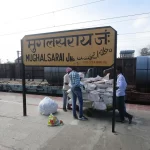
- Explore Katni, Madhya Pradesh: History, Culture, and Nature

- Ludhiana, Punjab, India – The Industrial Heartbeat with Timeless Heritage

- Unveiling Osmanabad (Dharashiv): Maharashtra’s Hidden Gem of History, Caves & Culture
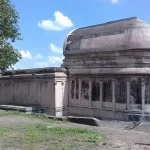
- Explore Sawantwadi: Maharashtra’s Hidden Gem of Heritage, Art, and Natural Splendour

